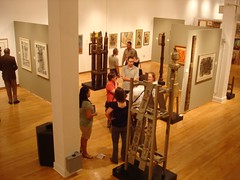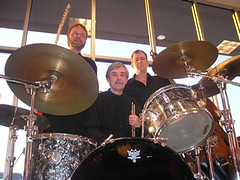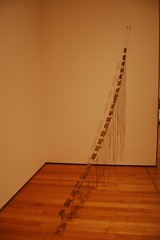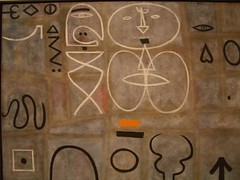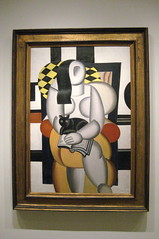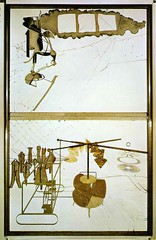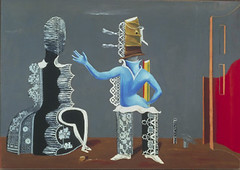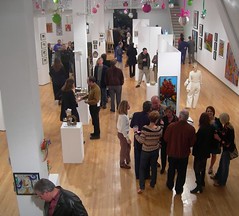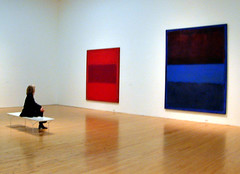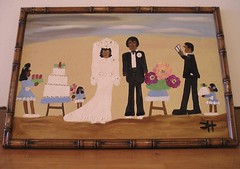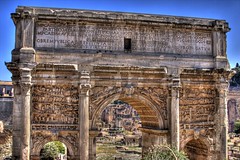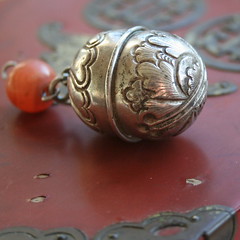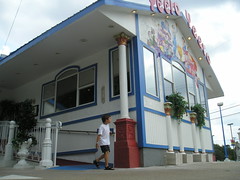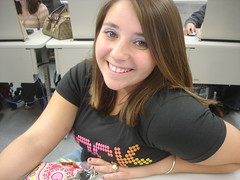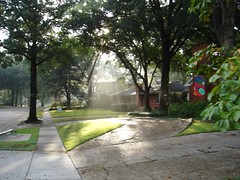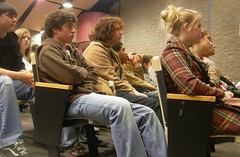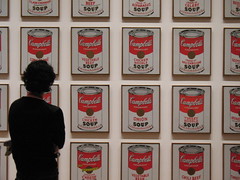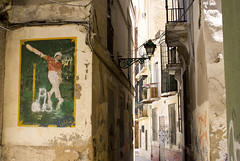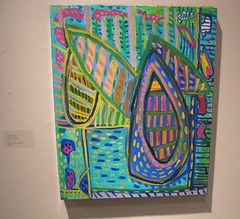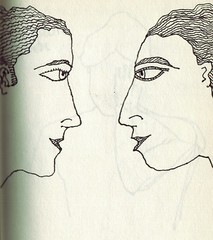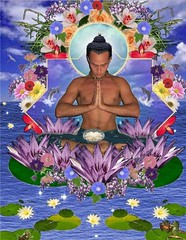Mr Trudeau's voice echoed grandly in the loft-like room dedicated to the artist Clyde Connell at Artspace. Her large abstract works consisting of torn paper glued to canvas simply displayed something only she could visualize.
Some of my classmates mumbled about how they or their siblings could make that kind of art But I saw an unusual coordination in the seemingly random-colored strips that Clyde could doubtlessly envisioned before she made the piece.
Her unusual made-up language confused many as we tried to decode the language only to have it revealed that it was a stylized surrealist technique.
My personal favorite work from her were the statue towers. They were simple but had a fascinating ability to convey emotion through something as simple as a chain.
Artspace, I have found, is one of my favorite parts of downtown Shreveport and is always worth a visit.
- Patrick Keene
Thursday, October 30, 2008
Going to the opera: Pagliacci and il Cavalleria Rusticana on Sat, Nov 8, 7:30 pm
Write a brief comparison of the stories in the operas Pagliacci and Cavalleria Rusticana. See the operas' synopses in a link to Wikipedia found at ShreveportOpera.org. See the links on the right side of this page.
Tuesday, October 28, 2008
Jazz - the background to the 20th century artistic explosion
Jazz review -
20’s and teens - early Creole jazz as developed in New Orleans and recorded in Chicago; Satchmo. Hot dance music.
30’s, 40’s - Swing jazz by big bands. Fletcher Henderson, Benny Goodman. Loud dance music.
Modern jazz: 50’s bebop - fast tempos, asymmetrical phrasing, intricate melodies. Not dance music.
New Orleans
Nouvelle Orleans
Vieux Carre
Congo Square
- dance, percussion, voice, melody, banjo
Creole
Quadroon Balls
African retention
Maroons, slave uprisings, Muslim names
Basin St.
red light district
New Orleans marching bands
Benevolent Societies / burials
Storyville, New Orleans
St Paul’s Bottoms, Shreveport
Progenitors of jazz -
1. Buddy Bolden
2. Joe King Oliver
3. Louis Moreau Gottschalk
4. Jelly Roll Morton
5. Original Dixieland Jass band
6. Kid Ory
7. Louis Armstrong
8. Fletcher Henderson
9. Duke Ellington
10. Count Basie
11. Cab Calloway
12. Earl Hines
13. improvisation
14. syncopation and polyrhythms
15. blue notes
16. griot
17. Benny Goodman
18. Glenn Miller
19. Lionel Hampton
20. Charlie Christian
21. Quintette du Hot Club de France
22. Django Reinhardt
23. Dixieland jazz
24. Bebop
25. Charlie Parker
26. Thelonius Monk
27. Dizzy Gillespie
28. Gil Evans
29. Miles Davis
30. John Coltrane
20’s and teens - early Creole jazz as developed in New Orleans and recorded in Chicago; Satchmo. Hot dance music.
30’s, 40’s - Swing jazz by big bands. Fletcher Henderson, Benny Goodman. Loud dance music.
Modern jazz: 50’s bebop - fast tempos, asymmetrical phrasing, intricate melodies. Not dance music.
New Orleans
Nouvelle Orleans
Vieux Carre
Congo Square
- dance, percussion, voice, melody, banjo
Creole
Quadroon Balls
African retention
Maroons, slave uprisings, Muslim names
Basin St.
red light district
New Orleans marching bands
Benevolent Societies / burials
Storyville, New Orleans
St Paul’s Bottoms, Shreveport
Progenitors of jazz -
1. Buddy Bolden
2. Joe King Oliver
3. Louis Moreau Gottschalk
4. Jelly Roll Morton
5. Original Dixieland Jass band
6. Kid Ory
7. Louis Armstrong
8. Fletcher Henderson
9. Duke Ellington
10. Count Basie
11. Cab Calloway
12. Earl Hines
13. improvisation
14. syncopation and polyrhythms
15. blue notes
16. griot
17. Benny Goodman
18. Glenn Miller
19. Lionel Hampton
20. Charlie Christian
21. Quintette du Hot Club de France
22. Django Reinhardt
23. Dixieland jazz
24. Bebop
25. Charlie Parker
26. Thelonius Monk
27. Dizzy Gillespie
28. Gil Evans
29. Miles Davis
30. John Coltrane
Monday, October 27, 2008
A comedic drama for the entire Fine Arts class: The Clean House at LSUS Nov 13 - 23
At 31, playwright Sarah Ruhl has already been a finalist for the Pulitzer Prize. Through her characters and her stories, she tackles big ideas with a voice that entertains and sets her apart from others, says NPR.org.
Ruhl's inspiration for her Pulitzer contender, The Clean House, came from a chance remark overheard at a party.
"My cleaning lady is depressed and won't clean my house," a doctor at the party said. "So I took her to the hospital and had her medicated. And she still won't clean!"
From that singular moment, Ruhl spun a tightly written play about laughter and death that somehow manages to avoid pretension. The Clean House was so successful that it has been honored with productions in the United States and Europe.
Now Ruhl is moving beyond that tight construction to an epic trilogy called Passion Play. It sets the story of Christ's crucifixion in three diverse locales: Elizabethan England, Hitler's Germany and Spearfish, S.D., during the Vietnam era.
Passion Play is very much a work in progress. But it reveals the breadth of Ruhl's imagination and represents a big step forward for the young writer.
The Clean House at LSUS
Director, Robert Alford
Thurs, November 13, 2008 at 8:00 pm through
Sunday, November 23, 2008 at 3:00pm
LSUS Black Box Theatre
Call 7975386
Email:
Robert.Alford@lsus.edu
Directed by Pruitt Taylor Vince with Nikai Clark, Emily Kirkland, Kelly Mills, James Palmer, Jennifer Lynn Warren
Ruhl's inspiration for her Pulitzer contender, The Clean House, came from a chance remark overheard at a party.
"My cleaning lady is depressed and won't clean my house," a doctor at the party said. "So I took her to the hospital and had her medicated. And she still won't clean!"
From that singular moment, Ruhl spun a tightly written play about laughter and death that somehow manages to avoid pretension. The Clean House was so successful that it has been honored with productions in the United States and Europe.
Now Ruhl is moving beyond that tight construction to an epic trilogy called Passion Play. It sets the story of Christ's crucifixion in three diverse locales: Elizabethan England, Hitler's Germany and Spearfish, S.D., during the Vietnam era.
Passion Play is very much a work in progress. But it reveals the breadth of Ruhl's imagination and represents a big step forward for the young writer.
The Clean House at LSUS
Director, Robert Alford
Thurs, November 13, 2008 at 8:00 pm through
Sunday, November 23, 2008 at 3:00pm
LSUS Black Box Theatre
Call 7975386
Email:
Robert.Alford@lsus.edu
Directed by Pruitt Taylor Vince with Nikai Clark, Emily Kirkland, Kelly Mills, James Palmer, Jennifer Lynn Warren
Sunday, October 26, 2008
Jazz music, the sonic background to the 20th century explosion in visual art
Let's say that jazz begins with an angelic entertainer from New Orleans named Louis Satchmo Armstrong.
Louis Armstrong (4 August 1901– July 6, 1971), nicknamed Satchmo, was an American jazz trumpeter and singer.
Coming to prominence in the 20s as an innovative cornet and trumpet virtuoso, Armstrong was a foundational influence on jazz, shifting the music's focus from collective improvisation to solo performers. With his distinctive gravelly voice, Armstrong was an influential singer, demonstrating great dexterity as an improviser, bending the lyrics and melody of a song for expressive purposes. He was also greatly skilled at scat singing, or wordless vocalizing.
Renowned for his charismatic stage presence, Armstrong's influence extended well beyond jazz, and by the end of his career in the '60s, he was widely regarded as a profound influence on popular music in general, and perhaps the most important American musician of the 20th century.
Armstrong died of a heart attack on July 6, 1971, at age 69, 11 months after playing a famous show at the Waldorf-Astoria's Empire Room. Shortly before his death he stated, "I think I had a beautiful life. I didn't wish for anything that I couldn't get and I got pretty near everything I wanted because I worked for it." He was residing in Corona, Queens, New York City, at the time of his passing. He was interred in Flushing Cemetery, Flushing, in Queens, New York City. His honorary pallbearers included Governor Rockefeller, Mayor Lindsay, Bing Crosby, Ella Fitzgerald, Guy Lombardo, Duke Ellington, Dizzy Gillespie, Pearl Bailey, Count Basie, Harry James, Frank Sinatra, Ed Sullivan, Earl Wilson, Alan King, Johnny Carson, David Frost, Merv Griffin, Dick Cavett and Bobby Hackett. Peggy Lee, one of Armstrong's favorite vocalists, sang The Lord's Prayer at the services.
Louis Armstrong (4 August 1901– July 6, 1971), nicknamed Satchmo, was an American jazz trumpeter and singer.
Coming to prominence in the 20s as an innovative cornet and trumpet virtuoso, Armstrong was a foundational influence on jazz, shifting the music's focus from collective improvisation to solo performers. With his distinctive gravelly voice, Armstrong was an influential singer, demonstrating great dexterity as an improviser, bending the lyrics and melody of a song for expressive purposes. He was also greatly skilled at scat singing, or wordless vocalizing.
Renowned for his charismatic stage presence, Armstrong's influence extended well beyond jazz, and by the end of his career in the '60s, he was widely regarded as a profound influence on popular music in general, and perhaps the most important American musician of the 20th century.
Armstrong died of a heart attack on July 6, 1971, at age 69, 11 months after playing a famous show at the Waldorf-Astoria's Empire Room. Shortly before his death he stated, "I think I had a beautiful life. I didn't wish for anything that I couldn't get and I got pretty near everything I wanted because I worked for it." He was residing in Corona, Queens, New York City, at the time of his passing. He was interred in Flushing Cemetery, Flushing, in Queens, New York City. His honorary pallbearers included Governor Rockefeller, Mayor Lindsay, Bing Crosby, Ella Fitzgerald, Guy Lombardo, Duke Ellington, Dizzy Gillespie, Pearl Bailey, Count Basie, Harry James, Frank Sinatra, Ed Sullivan, Earl Wilson, Alan King, Johnny Carson, David Frost, Merv Griffin, Dick Cavett and Bobby Hackett. Peggy Lee, one of Armstrong's favorite vocalists, sang The Lord's Prayer at the services.
Wednesday, October 22, 2008
Minimalism: Mondrian, Brancusi, Rothko, Stella, Connell
Minimalism describes movements in various forms of art and design, especially visual art and music, where the work is stripped down to its most fundamental features. As a specific movement in the arts it is identified with developments in post-World War II Western Art, most strongly with American visual arts in the late 1960s and early 1970s, says Wikipedia.
It is rooted in Modernism, and was a reaction against Abstract Expressionism and a bridge to Postmodern art practices.
The term "minimalist" is often applied to designate anything which is spare or stripped to its essentials. It has also been used to describe the plays of Samuel Beckett, the films of Robert Bresson, the stories of Raymond Carver.
Architect Ludwig Mies van der Rohe adopted the motto "Less is more" to describe his aesthetic tactic of arranging the numerous necessary components of a building to create an impression of extreme simplicity.
Minimalists in the golden era: Piet Mondrian, Constantin Brancusi, Mark Rothko, Eva Hesse. Much of Clyde Connell's work could be called minimalist.
It is rooted in Modernism, and was a reaction against Abstract Expressionism and a bridge to Postmodern art practices.
The term "minimalist" is often applied to designate anything which is spare or stripped to its essentials. It has also been used to describe the plays of Samuel Beckett, the films of Robert Bresson, the stories of Raymond Carver.
Architect Ludwig Mies van der Rohe adopted the motto "Less is more" to describe his aesthetic tactic of arranging the numerous necessary components of a building to create an impression of extreme simplicity.
Minimalists in the golden era: Piet Mondrian, Constantin Brancusi, Mark Rothko, Eva Hesse. Much of Clyde Connell's work could be called minimalist.
Minimalism: Adolph Gottlieb
Minimalism describes movements in various forms of art and design, especially visual art and music, where the work is stripped down to its most fundamental features. As a specific movement in the arts it is identified with developments in post-World War II Western Art, most strongly with American visual arts in the late 1960s and early 1970s, says Wikipedia.
It is rooted in Modernism, and was a reaction against Abstract Expressionism and a bridge to Postmodern art practices.
The term "minimalist" is often applied to designate anything which is spare or stripped to its essentials. It has also been used to describe the plays of Samuel Beckett, the films of Robert Bresson, the stories of Raymond Carver.
Architect Ludwig Mies van der Rohe adopted the motto "Less is more" to describe his aesthetic tactic of arranging the numerous necessary components of a building to create an impression of extreme simplicity.
Minimalists in the golden era: Piet Mondrian, Constantin Brancusi, Mark Rothko, Eva Hesse.
It is rooted in Modernism, and was a reaction against Abstract Expressionism and a bridge to Postmodern art practices.
The term "minimalist" is often applied to designate anything which is spare or stripped to its essentials. It has also been used to describe the plays of Samuel Beckett, the films of Robert Bresson, the stories of Raymond Carver.
Architect Ludwig Mies van der Rohe adopted the motto "Less is more" to describe his aesthetic tactic of arranging the numerous necessary components of a building to create an impression of extreme simplicity.
Minimalists in the golden era: Piet Mondrian, Constantin Brancusi, Mark Rothko, Eva Hesse.
MoMa: abstract expressionist Adolph Gottlieb
Adolph Gottlieb had a vast influence on the work of Louisiana artist Clyde Connell.
Here are notes on Gottlieb, one of the original NYC abstract expressionists, from Wikipedia:
Adolph Gottlieb (March 14, 1903 - March 4, 1974) was an American abstract expressionist painter and sculptor.
He was born in New York. From 1920-1921 he studied at the Art Students League of New York, after which he traveled in France and Germany for a year. Before his skills had fully developed he studied at the Académie de la Grande Chaumière in Paris. When he returned, he was one of the most traveled New York Artists. In the mid-1930’s, he became a teacher using his acquired technical and art history knowledge to teach while he painted.
During World War II, Gottlieb encountered exiled Surrealists in New York and they added to and reaffirmed his belief in the subconscious as the well for evocative and universal art. This belief led him to experiment with basic and elemental symbols. The results of his experiments manifested themselves in his series “Pictographs” which spanned from 1941-1950.
He is considered one of the first color field painters and is one of the forerunners of Lyrical Abstraction.
Here are notes on Gottlieb, one of the original NYC abstract expressionists, from Wikipedia:
Adolph Gottlieb (March 14, 1903 - March 4, 1974) was an American abstract expressionist painter and sculptor.
He was born in New York. From 1920-1921 he studied at the Art Students League of New York, after which he traveled in France and Germany for a year. Before his skills had fully developed he studied at the Académie de la Grande Chaumière in Paris. When he returned, he was one of the most traveled New York Artists. In the mid-1930’s, he became a teacher using his acquired technical and art history knowledge to teach while he painted.
During World War II, Gottlieb encountered exiled Surrealists in New York and they added to and reaffirmed his belief in the subconscious as the well for evocative and universal art. This belief led him to experiment with basic and elemental symbols. The results of his experiments manifested themselves in his series “Pictographs” which spanned from 1941-1950.
He is considered one of the first color field painters and is one of the forerunners of Lyrical Abstraction.
What does the word "provenance" mean, please?
provenance
* Place of origin; derivation.
* The history of the ownership of an object, especially when documented or authenticated. Used in regards artworks, antiques, and books.
* The records or documents authenticating such an object or the history of its ownership.
* Place of origin; derivation.
* The history of the ownership of an object, especially when documented or authenticated. Used in regards artworks, antiques, and books.
* The records or documents authenticating such an object or the history of its ownership.
René Magritte 'Time Transfixed, The Institute of Art of Chicago
"René Magritte was no doubt disappointed that, aside from the small circle of his kindred spirits among the Surrealists, the world needed over a quarter of a century to discover that his work has both philosophical and poetic content which corresponds to certain social and intellectual trends, particularly of the second half of the twentieth century. Magritte's work was not easy to approach at the outset, however. He is a difficult painter, and his simplicity is misleading."
"His work makes a constant call on us to relinquish, at least temporarily, our usual expectations of art. Magritte never responds to our demands and expectations. He offers us something else instead. His friend Paul Nougé has expressed the problem better than anyone else; what he said in 1944 still holds good: "We question pictures," he said, "before listening to them, we question them at random. And we are astonished when the reply we had expected is not forthcoming."
"Magritte's work allows one to conjure up a state of being which has become rare and precious - which makes it possible to observe in silence. Reading and reflection call for silence, listening no less. Silence can be used for waiting for an illumined vision of things, and it is to this vision that Magritte introduces us."
Thus it says at a very recommendable site, artchive.com.
"His work makes a constant call on us to relinquish, at least temporarily, our usual expectations of art. Magritte never responds to our demands and expectations. He offers us something else instead. His friend Paul Nougé has expressed the problem better than anyone else; what he said in 1944 still holds good: "We question pictures," he said, "before listening to them, we question them at random. And we are astonished when the reply we had expected is not forthcoming."
"Magritte's work allows one to conjure up a state of being which has become rare and precious - which makes it possible to observe in silence. Reading and reflection call for silence, listening no less. Silence can be used for waiting for an illumined vision of things, and it is to this vision that Magritte introduces us."
Thus it says at a very recommendable site, artchive.com.
Son of Man, a self-portrait by the surrealist Rene Magritte
René François Ghislain Magritte (21 November 1898 - 15 August 1967) was a Belgian surrealist artist. He became well-known for a number of witty and thought-provoking images.
A consummate technician, his work frequently displays a juxtaposition of ordinary objects in an unusual context, giving new meanings to familiar things. The representational use of objects as other than what they seem is typified in his painting, The Treachery of Images (La trahison des images), which shows a pipe that looks as though it is a model for a tobacco store advertisement. Magritte painted below the pipe "This is not a pipe" (Ceci n'est pas une pipe), which seems a contradiction, but is actually true: the painting is not a pipe, it is an image of a pipe.
Popular interest in Magritte's work rose considerably in the 1960s, and his imagery has influenced pop, minimalist and conceptual art.
A consummate technician, his work frequently displays a juxtaposition of ordinary objects in an unusual context, giving new meanings to familiar things. The representational use of objects as other than what they seem is typified in his painting, The Treachery of Images (La trahison des images), which shows a pipe that looks as though it is a model for a tobacco store advertisement. Magritte painted below the pipe "This is not a pipe" (Ceci n'est pas une pipe), which seems a contradiction, but is actually true: the painting is not a pipe, it is an image of a pipe.
Popular interest in Magritte's work rose considerably in the 1960s, and his imagery has influenced pop, minimalist and conceptual art.
NYC - Metropolitan Museum of Art: Fernand Léger's Woman with a Cat
Joseph Fernand Henri Léger (February 4, 1881 – August 17, 1955) was a French painter, sculptor, and filmmaker.
He was a cubist whose specialty was a mechanical style. He favored tubular geometric forms in his cubist renderings.
In 1924, in collaboration with Man Ray, Léger produced and directed the iconic and Futurism-influenced film, Ballet Mécanique (Mechanical Ballet). Neither abstract nor narrative, it is a series of images of a woman's lips and teeth, close-up shots of ordinary objects, and repeated images of human activities and machines in rhythmic movement.
In November 2003, his painting, La femme en rouge et vert, sold for 22 million United States dollars. His sculptures have been selling in excess of 8 million dollars.
He was a cubist whose specialty was a mechanical style. He favored tubular geometric forms in his cubist renderings.
In 1924, in collaboration with Man Ray, Léger produced and directed the iconic and Futurism-influenced film, Ballet Mécanique (Mechanical Ballet). Neither abstract nor narrative, it is a series of images of a woman's lips and teeth, close-up shots of ordinary objects, and repeated images of human activities and machines in rhythmic movement.
In November 2003, his painting, La femme en rouge et vert, sold for 22 million United States dollars. His sculptures have been selling in excess of 8 million dollars.
Robert Mapplethorpe: one of the most controversial of recent photographer artists
Robert Mapplethorpe (November 4, 1946 – March 9, 1989) was an American photographer, known for his large-scale, highly stylized black and white portraits, photos of flowers and naked men.
The frank, homosexual eroticism of some of the work of his middle period triggered a more general controversy about the public funding of artworks, says Wikipedia.
Mapplethorpe was born and grew up as a Roman Catholic of English and Irish heritage in Our Lady of the Snows Parish in Floral Park, New York, a neighborhood of Long Island. He received a B.F.A. from Pratt Institute in Brooklyn, where he majored in graphic arts.[1]
In the mid-1970s, he acquired a Hasselblad medium-format camera and began taking photographs of a wide circle of friends and acquaintances, including artists, composers, and socialites. In the 1980s he refined his aesthetic, photographing statuesque male and female nudes, delicate flower still lifes, and highly formal portraits of artists and celebrities.
In 2006, a Mapplethorpe print of Andy Warhol was auctioned for $643,200, making it the 6th most expensive photograph ever sold.
The frank, homosexual eroticism of some of the work of his middle period triggered a more general controversy about the public funding of artworks, says Wikipedia.
Mapplethorpe was born and grew up as a Roman Catholic of English and Irish heritage in Our Lady of the Snows Parish in Floral Park, New York, a neighborhood of Long Island. He received a B.F.A. from Pratt Institute in Brooklyn, where he majored in graphic arts.[1]
In the mid-1970s, he acquired a Hasselblad medium-format camera and began taking photographs of a wide circle of friends and acquaintances, including artists, composers, and socialites. In the 1980s he refined his aesthetic, photographing statuesque male and female nudes, delicate flower still lifes, and highly formal portraits of artists and celebrities.
In 2006, a Mapplethorpe print of Andy Warhol was auctioned for $643,200, making it the 6th most expensive photograph ever sold.
Tuesday, October 21, 2008
Money on Wed; open notes quiz Thurs and brief field trip on Fri
1) Three bucks! Please bring it Wed so we can establish a class fund for field trips.
2) The open notes quiz Thurs will be on 20th century artists and terms.
You may print out the last notes after my planning period Wed.
3) Fri we will go to Artspace during our 1:20 to 2:25 class. Please go directly to the bus in front of school at 1:20. Our goals are to establish
a) the location and opportunity offered by Artspace, 710 Texas St.
b) the bio and importance of Clyde Connell.
c) the art of curating an exhibit.
2) The open notes quiz Thurs will be on 20th century artists and terms.
You may print out the last notes after my planning period Wed.
3) Fri we will go to Artspace during our 1:20 to 2:25 class. Please go directly to the bus in front of school at 1:20. Our goals are to establish
a) the location and opportunity offered by Artspace, 710 Texas St.
b) the bio and importance of Clyde Connell.
c) the art of curating an exhibit.
Monday, October 20, 2008
sigur rós: avant garde?
Avant-garde means "advance guard" or "vanguard."[1] The adjective form is used in English, to refer to people or works that are experimental or innovative, particularly with respect to art, culture, and politics, says Wikipedia.
Avant-garde represents a pushing of the boundaries of what is accepted as the norm or the status quo, primarily in the cultural realm. The notion of the existence of the avant-garde is considered by some to be a hallmark of modernism, as distinct from postmodernism. However, this is not true in the case of music as many pieces are still being released which are generally considered avant-garde in popular culture.[2]
Many artists have aligned themselves with the avant-garde and still continue to do so, tracing a history from Dada to the Situationists to postmodern artists.
Who's avant garde in music? Has the artistic Prince qulaified at times?
Is the Brit group called Radiohead an avant band? Is the Icelandic group Sigur Ros?
Depends on how tight you want to be with your definition.
In my day the singer David Bowie was avant. Frank Zappa was, too.
Today the first person who comes to mind is visual artist (sharks in formaldehyde) Damien Hirst.
Avant-garde represents a pushing of the boundaries of what is accepted as the norm or the status quo, primarily in the cultural realm. The notion of the existence of the avant-garde is considered by some to be a hallmark of modernism, as distinct from postmodernism. However, this is not true in the case of music as many pieces are still being released which are generally considered avant-garde in popular culture.[2]
Many artists have aligned themselves with the avant-garde and still continue to do so, tracing a history from Dada to the Situationists to postmodern artists.
Who's avant garde in music? Has the artistic Prince qulaified at times?
Is the Brit group called Radiohead an avant band? Is the Icelandic group Sigur Ros?
Depends on how tight you want to be with your definition.
In my day the singer David Bowie was avant. Frank Zappa was, too.
Today the first person who comes to mind is visual artist (sharks in formaldehyde) Damien Hirst.
France: center of early twentieth century art
Locations to know in France:
- Paris, center of the world of fine arts since Louis XIV.
- Marseille (2nd pop.)
- Mediterranean coastline east of Marseille called Riviera or Cote d'Azur
- Loire River valley famous for palaces called chateaux.
- Wine regions such as Bordeaux and Burgundy are governed by law so as to control the credibility of the profit-making wine system.
- Provence is one region near the Cote d'Azur where artists have congregated. Exs: Matisse and Picasso.
- Paris, center of the world of fine arts since Louis XIV.
- Marseille (2nd pop.)
- Mediterranean coastline east of Marseille called Riviera or Cote d'Azur
- Loire River valley famous for palaces called chateaux.
- Wine regions such as Bordeaux and Burgundy are governed by law so as to control the credibility of the profit-making wine system.
- Provence is one region near the Cote d'Azur where artists have congregated. Exs: Matisse and Picasso.
The wine ritual, part of the life of European artists and a life in the fine arts
Bordeaux and Burgundy:
- Bottle on the left has "shoulders" and thus indicates a Bordeaux, made from garpes grown somewhere in the south-west of France.
Bottles on the right having sloping shoulders, or "no shoulders" and therefore indicates origin in the northeast of France, the region known as Burgundy. One of the many types of wine in Burgundy is champagne, the sparkling wine. Both Bordeaux and Burgundy grows both red and white wines.
Does your waiter place your bottle of wine on the table or does he bring an ice bucket and stand to your table?
- If it's red wine, it is traditionally served at room temperature. If it is white wine, the waiter will add an ice bucket; it is traditionally served chilled.
What is the head of table deciding when the waiter pours a small bit of wine for him before anyone else?
- He's tasting it to see whether the wine has become vinegary, or sour, or "bad." He is Not tasting it to see whether he likes it.
Head of table examines the cork?
- if the cork is too dry there may have been air leakage and the wine might have soured. Yet a look at the cork is Not definitive.
- Bottle on the left has "shoulders" and thus indicates a Bordeaux, made from garpes grown somewhere in the south-west of France.
Bottles on the right having sloping shoulders, or "no shoulders" and therefore indicates origin in the northeast of France, the region known as Burgundy. One of the many types of wine in Burgundy is champagne, the sparkling wine. Both Bordeaux and Burgundy grows both red and white wines.
Does your waiter place your bottle of wine on the table or does he bring an ice bucket and stand to your table?
- If it's red wine, it is traditionally served at room temperature. If it is white wine, the waiter will add an ice bucket; it is traditionally served chilled.
What is the head of table deciding when the waiter pours a small bit of wine for him before anyone else?
- He's tasting it to see whether the wine has become vinegary, or sour, or "bad." He is Not tasting it to see whether he likes it.
Head of table examines the cork?
- if the cork is too dry there may have been air leakage and the wine might have soured. Yet a look at the cork is Not definitive.
Saturday, October 18, 2008
Marcel Duchamp, the Large Glass
Duchamp, The Bride Stripped Bare by her Bachelors, Even (the Large Glass), 1915-1923
One of the most famous pieces of the dada and surrealist movements.
One of the most famous pieces of the dada and surrealist movements.
Friday, October 17, 2008
Max Ernst. Le couple, 1923: a serial surrealist
Max Ernst (2 April 1891 – 1 April 1976) was a German painter, sculptor, graphic artist, and poet, considered one of the chief representatives of Dadaism and Surrealism.
In 1922, he joined fellow Dadaists André Breton, Gala, Tristan Tzara, Paul Éluard at the artistic community of Montparnasse.[1] Constantly experimenting, in 1925 he invented a graphic art technique called frottage, which uses pencil rubbings of objects as a source of images.
The next year he collaborated with Joan Miró on designs for Sergei Diaghilev. With Miró's help, Ernst pioneered grattage in which he troweled pigment from his canvases. He also explored with the technique of decalcomania which involves pressing paint between two surfaces.[3]
Ernst developed a fascination with birds that was prevalent in his work. His alter ego in paintings, which he called Loplop, was a bird. He suggested this alter-ego was an extension of himself stemming from an early confusion of birds and humans. He said his sister was born soon after his bird died.
Ernst and Guggenheim arrived in the United States in 1941 and were married the following year. Along with other artists and friends (Marcel Duchamp and Marc Chagall) who had fled from the war and lived in New York City, Ernst helped inspire the development of Abstract expressionism.
In 1922, he joined fellow Dadaists André Breton, Gala, Tristan Tzara, Paul Éluard at the artistic community of Montparnasse.[1] Constantly experimenting, in 1925 he invented a graphic art technique called frottage, which uses pencil rubbings of objects as a source of images.
The next year he collaborated with Joan Miró on designs for Sergei Diaghilev. With Miró's help, Ernst pioneered grattage in which he troweled pigment from his canvases. He also explored with the technique of decalcomania which involves pressing paint between two surfaces.[3]
Ernst developed a fascination with birds that was prevalent in his work. His alter ego in paintings, which he called Loplop, was a bird. He suggested this alter-ego was an extension of himself stemming from an early confusion of birds and humans. He said his sister was born soon after his bird died.
Ernst and Guggenheim arrived in the United States in 1941 and were married the following year. Along with other artists and friends (Marcel Duchamp and Marc Chagall) who had fled from the war and lived in New York City, Ernst helped inspire the development of Abstract expressionism.
The bourgeoisie and art
Bourgeoisie is a classification used in analyzing human societies to describe the upper middle social class of people, says Wikipedia.
The bourgeoisie are members of the upper or merchant class, whose status or power comes from employment, education, and wealth. They are distinguished from those whose power comes from being born into an aristocratic family.
The term petite bourgeoisie (also petty bourgeoisie) is used to describe the class below the bourgeoisie but above the proletariat.
The term "urban haute bourgeois" describes American upper-class WASPs.
WASPs have been the dominant ethnic group (white, Anglo-Saxon, Protestant) for most of US history. Until JFK in 1960 all presidents had been WASPs. Most US business leaders and Senators were WASPs during the 1700's and 1800's. Generally, they were bourgeois or of the wealthy class.
WASPs were guilty of excluding Jews, Blacks, Southern Europeans (ex, Italians), Irish and Asians from the better housing and jobs in US life. During the Holocaust, WASP members of the US government severely limited Jewish immigration to the US - despite knowledge of Hitler's extermminations.
In common usage the term has pejorative connotations suggesting either undeserved wealth, or lifestyles, tastes, and opinions that lack the sophistication of the rich or the authenticity of the intellectual or the poor, continues Wikipedia. In the United States, where social class affiliation lacks some of the structure and rules of many other nations, "bourgeoisie" is sometimes used to refer to those seen as being either upper class or upper middle class. It is rare for people in the English speaking world to identify themselves as members of the bourgeoisie, although many self-identify as middle class.
In the late Middle Ages, as cities were emerging, artisans and tradesmen began to emerge as both a physical and economic force. They formed guilds, associations and companies to conduct business and promote their own interests. These people were the original bourgeoisie. In the late Middle Ages (the 14th and 15th centuries), they were the highest guildsmen and artisans, as evidenced in their ability to pay the fines for breaking sumptuary laws, and by paying to be called citizens of the city in which they lived or the ability to be called bourgeoisie. In fact the King of France granted nobility to all of the bourgeoisie of Paris in the late fourteenth century. They eventually allied with the kings in uprooting the feudalist system.
After the Middle Ages and going into the renaissance they were gradually becoming the ruling class in industrialised nation-states. In the 17th and 18th century, they generally supported the American revolution and French revolution in overthrowing the laws and privileges of the absolutist feudal order, clearing the way for the rapid expansion of commerce and the establishment of a capitalist society.
The bourgeoisie was never without its critics; it was first accused of narrow-mindedness, materialism, hypocrisy, and lack of culture, among other things, by persons such as the playwright Truldière and the novelist Flaubert, who denounced its supposed banality and mercenary aspirations.
The term is essential to the Communist Manifesto, by Karl Marx and Friedrich Engels; it's equivalent to the Upper Class.
The bourgeoisie are members of the upper or merchant class, whose status or power comes from employment, education, and wealth. They are distinguished from those whose power comes from being born into an aristocratic family.
The term petite bourgeoisie (also petty bourgeoisie) is used to describe the class below the bourgeoisie but above the proletariat.
The term "urban haute bourgeois" describes American upper-class WASPs.
WASPs have been the dominant ethnic group (white, Anglo-Saxon, Protestant) for most of US history. Until JFK in 1960 all presidents had been WASPs. Most US business leaders and Senators were WASPs during the 1700's and 1800's. Generally, they were bourgeois or of the wealthy class.
WASPs were guilty of excluding Jews, Blacks, Southern Europeans (ex, Italians), Irish and Asians from the better housing and jobs in US life. During the Holocaust, WASP members of the US government severely limited Jewish immigration to the US - despite knowledge of Hitler's extermminations.
In common usage the term has pejorative connotations suggesting either undeserved wealth, or lifestyles, tastes, and opinions that lack the sophistication of the rich or the authenticity of the intellectual or the poor, continues Wikipedia. In the United States, where social class affiliation lacks some of the structure and rules of many other nations, "bourgeoisie" is sometimes used to refer to those seen as being either upper class or upper middle class. It is rare for people in the English speaking world to identify themselves as members of the bourgeoisie, although many self-identify as middle class.
In the late Middle Ages, as cities were emerging, artisans and tradesmen began to emerge as both a physical and economic force. They formed guilds, associations and companies to conduct business and promote their own interests. These people were the original bourgeoisie. In the late Middle Ages (the 14th and 15th centuries), they were the highest guildsmen and artisans, as evidenced in their ability to pay the fines for breaking sumptuary laws, and by paying to be called citizens of the city in which they lived or the ability to be called bourgeoisie. In fact the King of France granted nobility to all of the bourgeoisie of Paris in the late fourteenth century. They eventually allied with the kings in uprooting the feudalist system.
After the Middle Ages and going into the renaissance they were gradually becoming the ruling class in industrialised nation-states. In the 17th and 18th century, they generally supported the American revolution and French revolution in overthrowing the laws and privileges of the absolutist feudal order, clearing the way for the rapid expansion of commerce and the establishment of a capitalist society.
The bourgeoisie was never without its critics; it was first accused of narrow-mindedness, materialism, hypocrisy, and lack of culture, among other things, by persons such as the playwright Truldière and the novelist Flaubert, who denounced its supposed banality and mercenary aspirations.
The term is essential to the Communist Manifesto, by Karl Marx and Friedrich Engels; it's equivalent to the Upper Class.
Wednesday, October 15, 2008
Mark Rothko
Mark Rothko, born Marcus Rothkowitz (Latvian: Marks Rotko; September 25, 1903–February 25, 1970), was a Latvian-born American painter and printmaker, says Wikipedia. He is classified as an abstract expressionist, although he rejected not only the label but even being called an abstract painter.
During the Depression Rothko found employment, as did many other artists, with the Works Progress Administration, a labor relief agency created under Roosevelt’s New Deal in response to the economic crisis. As the Depression waned, Rothko continued on in government service, working for TRAP, an agency that employed artists, architects and laborers in the restoration and renovation of public buildings. Avery, DeKooning, Pollock, Reinhardt, David Smith, Louise Nevelson, and Rothko’s old teacher, Arshile Gorky, were also employed by TRAP.
In 1936, Rothko began writing a book, never completed, about the similarities in the art of children and the work of modern painters. The work of modernists, influenced by primitive art, could be compared to that of children in that "child art," according to Rothko, "transforms itself into primitivism, which is only the child producing a mimicry of himself." In this same manuscript, he observed that "the fact that one usually begins with drawing is already academic. We start with color."
The "Abstract Expressionist" movement was a loose consortium of mostly secular, urban Jews including Rothko and two other artists he was associated with, Gottlieb and Newman. Self-perceived outsiders and intellectuals, they viewed the freedom afforded by Modernism with no small degree of suspicion, interpreting this freedom as a source of suffering as opposed to release.
In 1961 a retrospective of his work was held at the Museum of Modern Art, to considerable commercial and critical success. In spite of this newfound notoriety, the art world had turned its attention from the now passé abstract expressionists to the "next big thing", Pop Art, particularly the work of Warhol, Lichtenstein, and Rosenquist.
The most exciting chapter of his life in art was the six-year period in which he prepared paintings for the Menil family in Houston.
The Rothko Chapel is located adjacent to the Menil Collection and The University of St. Thomas in Houston, Texas. The building is small, windowless, and unassuming. It is a decidedly geometric, postmodern structure, located in a turn of the century middle-class Houston neighborhood. The Chapel, the Menil Collection, and the nearby Cy Twombly gallery were funded by Texas oil millionaires John and Dominique de Menil.
Rothko never saw the completed Chapel and never installed the giant paintings. On February 28, 1971, at the dedication, Dominique De Menil said of the paintings: "We are cluttered with images and only abstract art can bring us to the threshold of the divine", noting Rothko’s courage in painting these impenetrable fortresses of color. The drama for many critics of Rothko’s work is the uneasy position of the paintings between, as Chase notes, "nothingness or vapidity" and "dignified ‘mute icons’ offering ‘the only kind of beauty we find acceptable today’."
In the spring of 1968, Rothko suffered an aneurysm of the aorta, a result of his chronic high blood pressure. Ignoring doctor’s orders, Rothko continued to drink and smoke heavily, avoid exercise and to maintain an unhealthy diet.
On February 25, 1970, Oliver Steindecker, Rothko’s assistant, found the artist in his kitchen, lying dead on the floor in front of the sink, covered in blood. His arms had been sliced open with a razor lying at his side. During autopsy it was discovered he had also overdosed on anti-depressants. He was 66 years old.
During the Depression Rothko found employment, as did many other artists, with the Works Progress Administration, a labor relief agency created under Roosevelt’s New Deal in response to the economic crisis. As the Depression waned, Rothko continued on in government service, working for TRAP, an agency that employed artists, architects and laborers in the restoration and renovation of public buildings. Avery, DeKooning, Pollock, Reinhardt, David Smith, Louise Nevelson, and Rothko’s old teacher, Arshile Gorky, were also employed by TRAP.
In 1936, Rothko began writing a book, never completed, about the similarities in the art of children and the work of modern painters. The work of modernists, influenced by primitive art, could be compared to that of children in that "child art," according to Rothko, "transforms itself into primitivism, which is only the child producing a mimicry of himself." In this same manuscript, he observed that "the fact that one usually begins with drawing is already academic. We start with color."
The "Abstract Expressionist" movement was a loose consortium of mostly secular, urban Jews including Rothko and two other artists he was associated with, Gottlieb and Newman. Self-perceived outsiders and intellectuals, they viewed the freedom afforded by Modernism with no small degree of suspicion, interpreting this freedom as a source of suffering as opposed to release.
In 1961 a retrospective of his work was held at the Museum of Modern Art, to considerable commercial and critical success. In spite of this newfound notoriety, the art world had turned its attention from the now passé abstract expressionists to the "next big thing", Pop Art, particularly the work of Warhol, Lichtenstein, and Rosenquist.
The most exciting chapter of his life in art was the six-year period in which he prepared paintings for the Menil family in Houston.
The Rothko Chapel is located adjacent to the Menil Collection and The University of St. Thomas in Houston, Texas. The building is small, windowless, and unassuming. It is a decidedly geometric, postmodern structure, located in a turn of the century middle-class Houston neighborhood. The Chapel, the Menil Collection, and the nearby Cy Twombly gallery were funded by Texas oil millionaires John and Dominique de Menil.
Rothko never saw the completed Chapel and never installed the giant paintings. On February 28, 1971, at the dedication, Dominique De Menil said of the paintings: "We are cluttered with images and only abstract art can bring us to the threshold of the divine", noting Rothko’s courage in painting these impenetrable fortresses of color. The drama for many critics of Rothko’s work is the uneasy position of the paintings between, as Chase notes, "nothingness or vapidity" and "dignified ‘mute icons’ offering ‘the only kind of beauty we find acceptable today’."
In the spring of 1968, Rothko suffered an aneurysm of the aorta, a result of his chronic high blood pressure. Ignoring doctor’s orders, Rothko continued to drink and smoke heavily, avoid exercise and to maintain an unhealthy diet.
On February 25, 1970, Oliver Steindecker, Rothko’s assistant, found the artist in his kitchen, lying dead on the floor in front of the sink, covered in blood. His arms had been sliced open with a razor lying at his side. During autopsy it was discovered he had also overdosed on anti-depressants. He was 66 years old.
Marcel Duchamp : Fontaine (1917)
Marcel Duchamp (1887 – 1968) was a French artist whose work is most often associated with the Dadaist and Surrealist movements, says Wikipedia. Duchamp's output had considerable influence on the development of post-World War I Western art, and whose advice to modern art collectors helped shape the tastes of the Western art world.
A playful man, Duchamp prodded thought about artistic processes and art marketing, not so much with words, but with actions such as dubbing a urinal "art" and naming it Fountain. He produced relatively few artworks as he quickly moved through the avant-garde rhythms of his time.
The creative act is not performed by the artist alone; the spectator brings the work in contact with the external world by deciphering and interpreting its inner qualifications and thus adds his contribution to the creative act.[1]
Duchamp's first controversial work, Nude Descending a Staircase, No. 2 (Nu descendant un escalier n° 2) (1912), depicts the motion of the mechanistic nude with superimposed facets, similar to motion pictures. The painting shows elements of both the fragmentation and synthesis of the Cubists, and the movement and dynamism of the Futurists.
He first submitted the piece to appear at the Cubist Salon des Indépendants, but jurist Albert Gleizes asked Duchamp's brothers to have him voluntarily withdraw the painting, or paint over the title that he had painted on the work and rename it something else. His brothers did approach him with Gleizes' request, and Duchamp quietly refused. Of the incident Duchamp later recalled, "I said nothing to my brothers. But I went immediately to the show and took my painting home in a taxi. It was really a turning point in my life, I can assure you. I saw that I would not be very much interested in groups after that."
Later he submitted the painting to the 1913 Armory Show in New York City -- officially the International Exhibition of Modern Art -- which displayed works of American artists and was the first major exhibition of the modern trends coming out of Paris. American show-goers, accustomed to realistic art, were scandalized, and the Nude was at the center of much of the controversy.
Work on The Large Glass continued into 1913 with his invention of inventing a repertoire of forms with notes, sketches and painted studies, and even drawing some of his ideas on the wall of his apartment.
In his studio he mounted a bicycle wheel upside down onto a stool, spinning it occasionally just to watch it. Later he denied that its creation was purposeful, though it has come to be known as the first of his readymades. "I enjoyed looking at it", he said. "Just as I enjoy looking at the flames dancing in the fireplace."
Meanwhile, Nude Descending a Staircase No. 2 was scandalizing Americans at the Armory Show, and the sale of all four of his paintings in the show financed his trip to America in 1915.
After World War I was declared in 1914, with his brothers and many friends in military service and himself exempted, Paris felt uncomfortable to Duchamp. He decided to emigrate to the then neutral United States. To his surprise he found he was a celebrity when he arrived in New York in 1915 where he quickly befriended art patron Katherine Dreier and artist Man Ray.
New York Dada had a less serious tone than that of Europe, and was not a particularly organized venture. Duchamp's friend Picabia connected with the Dada group in Zürich, bringing to New York the Dada ideas of absurdity and anti-art. Together with Man Ray and many from the group that met almost nightly at the Arensberg home or caroused in Greenwich Village, Duchamp contributed his ideas about art and his humor to the New York activities, much of which ran concurrent with the development of readymades and The Large Glass. (See also found art.)
Duchamp and Dada are most often connected by his submission of Fountain, a urinal, to the Society of Independent Artists exhibit in 1917. The Independent Artists shows were unjuried and all pieces that were submitted were displayed. However, the show committee said that Fountain was not art and rejected it from the show causing an uproar amongst the Dadaists and led Duchamp to resign from the board of the Independent Artists.[2]
Along with Henri-Pierre Roché and Beatrice Wood, Duchamp published New York's Dada's magazine, The Blind Man which included art, literature, humor and commentary.
In 1915 Duchamp began doing his "readymades" — found objects he chose and presented as art. He assembled the first readymade, a bicycle wheel mounted on a stool, in 1913 about the same time as his Nude Descending A Staircase was attracting the attention of critics at the International Exhibition of Modern Art, though it wasn't until two years later he called it a readymade.
Bottle Rack (1914), a bottle drying rack signed by Duchamp, is considered to be the first "pure" readymade. Prelude to a Broken Arm (November 1915), a snow shovel, followed soon after. In 1919, Duchamp made a Mona Lisa parody by adorning a cheap reproduction with a moustache and a goatee, as well as adding the rude inscription L.H.O.O.Q., when read out loud in French sounds like "Elle a chaud au cul" (translating to "she has a hot ass" as a manner of implying the woman in the painting is in a state of sexual excitement and availability). This was intended as a Freudian joke, referring to Leonardo da Vinci's alleged homosexuality. According to Rhonda Roland Shearer, the apparent reproduction is in fact a copy partly modelled on Duchamp's own face.[3]
His Fountain, the urinal signed with the pseudonym R. Mutt that shocked the art world in 1917, was selected in 2004 as "the most influential artwork of the 20th century" by 500 renowned artists and historians.[4]
Rrose Sélavy, also spelled Rose Sélavy, was one of Duchamp's pseudonyms. The name, a pun, sounds like the French phrase "Eros, c'est la vie", which translates to English as "Eros, such is life". It has also been read as "arroser la vie" ("to make a toast to life").
Sélavy emerged in 1921 in a series of photographs by Man Ray of Duchamp dressed as a woman. Through the 1920s Man Ray and Duchamp collaborated on more photos of Sélavy. Duchamp later used the name as the byline on written material and signed several creations with it. Duchamp used the name in the title of at least one sculpture, Why Not Sneeze Rrose Sélavy?. The sculpture, a type of readymade called an assemblage, consists of an oral thermometer, a couple dozen small cubes of marble resembling sugar cubes inside a birdcage.
Duchamp became a United States citizen in 1955 but his influence on the art world remained behind the scenes until the late 1950s when he was "discovered" by young artists such as Robert Rauschenberg and Jasper Johns who were eager to escape the dominance of Abstract Expressionism.
Interest in Duchamp reignited in the 1960s, and he gained international public recognition. 1963 saw his first retrospective exhibition at the Pasadena Art Museum, and in 1966 the Tate Gallery hosted a large exhibit of his work. Other major institutions, including the Philadelphia Art Museum and the Metropolitan Museum of Art, followed with large showings of Duchamp's work. He was invited to lecture on art and participate in formal discussions, as well as sitting for interviews with major publications.
1938 - The International Surrealist Exhibition was held at the Beaux-arts Gallery, Paris with more than 60 artists from different countries, showing around 300 paintings, objects, collages, photographs and installations.
The surrealists wanted to create an exhibition which in itself would be a creative act and called on Duchamp to do so. At the exhibition's entrance he placed Salvador Dalí's Rainy Taxi (an old taxi rigged to produce a steady drizzle of water down the inside of the windows, and a shark-headed creature in the driver's seat and a blond mannequin crawling with live snails in the back) greeted the patrons who were in full evening dress. Surrealist Street filled one side of the lobby with mannequins dressed by various surrealists. He designed the main hall to seem like subterranean cave with 1,200 coal bags suspended from the ceiling over a coal brazier with a single light bulb which provided the only lighting,[1] so patrons were given flashlights with which to view the art. Wolfgang Paalens installation underneath was composed of limp oak leaves and a water-filled pond with actual water lilies and reed, and the aroma of roasting coffee filled the air. Around midnight in the crazy gleam of the pale light cones the visitors witness the dancing shimmer of a sparsely dressed girl who suddenly arises from the reed, jumps on the bed, abruptly lapses into a hysterical shriek - an idea of Dali -, and disappears just as quickly.
Much to the surrealists' satisfaction the exhibition scandalized the viewers.
1942 - For the First Papers of Surrealism show in New York, surrealists again called on Duchamp to design the exhibition. This time he wove a 3-dimensional web of string throughout the rooms of the space, in some cases making it almost impossible to see the works.[2] He made a secret arrangement with an associate's son to bring his friends to the opening of the show, so that when the finely dressed patrons arrived they found a dozen children in athletic clothes kicking and passing balls, and skipping rope. His design for the show's catalog included "found", rather than posed, photographs of the artists.
A playful man, Duchamp prodded thought about artistic processes and art marketing, not so much with words, but with actions such as dubbing a urinal "art" and naming it Fountain. He produced relatively few artworks as he quickly moved through the avant-garde rhythms of his time.
The creative act is not performed by the artist alone; the spectator brings the work in contact with the external world by deciphering and interpreting its inner qualifications and thus adds his contribution to the creative act.[1]
Duchamp's first controversial work, Nude Descending a Staircase, No. 2 (Nu descendant un escalier n° 2) (1912), depicts the motion of the mechanistic nude with superimposed facets, similar to motion pictures. The painting shows elements of both the fragmentation and synthesis of the Cubists, and the movement and dynamism of the Futurists.
He first submitted the piece to appear at the Cubist Salon des Indépendants, but jurist Albert Gleizes asked Duchamp's brothers to have him voluntarily withdraw the painting, or paint over the title that he had painted on the work and rename it something else. His brothers did approach him with Gleizes' request, and Duchamp quietly refused. Of the incident Duchamp later recalled, "I said nothing to my brothers. But I went immediately to the show and took my painting home in a taxi. It was really a turning point in my life, I can assure you. I saw that I would not be very much interested in groups after that."
Later he submitted the painting to the 1913 Armory Show in New York City -- officially the International Exhibition of Modern Art -- which displayed works of American artists and was the first major exhibition of the modern trends coming out of Paris. American show-goers, accustomed to realistic art, were scandalized, and the Nude was at the center of much of the controversy.
Work on The Large Glass continued into 1913 with his invention of inventing a repertoire of forms with notes, sketches and painted studies, and even drawing some of his ideas on the wall of his apartment.
In his studio he mounted a bicycle wheel upside down onto a stool, spinning it occasionally just to watch it. Later he denied that its creation was purposeful, though it has come to be known as the first of his readymades. "I enjoyed looking at it", he said. "Just as I enjoy looking at the flames dancing in the fireplace."
Meanwhile, Nude Descending a Staircase No. 2 was scandalizing Americans at the Armory Show, and the sale of all four of his paintings in the show financed his trip to America in 1915.
After World War I was declared in 1914, with his brothers and many friends in military service and himself exempted, Paris felt uncomfortable to Duchamp. He decided to emigrate to the then neutral United States. To his surprise he found he was a celebrity when he arrived in New York in 1915 where he quickly befriended art patron Katherine Dreier and artist Man Ray.
New York Dada had a less serious tone than that of Europe, and was not a particularly organized venture. Duchamp's friend Picabia connected with the Dada group in Zürich, bringing to New York the Dada ideas of absurdity and anti-art. Together with Man Ray and many from the group that met almost nightly at the Arensberg home or caroused in Greenwich Village, Duchamp contributed his ideas about art and his humor to the New York activities, much of which ran concurrent with the development of readymades and The Large Glass. (See also found art.)
Duchamp and Dada are most often connected by his submission of Fountain, a urinal, to the Society of Independent Artists exhibit in 1917. The Independent Artists shows were unjuried and all pieces that were submitted were displayed. However, the show committee said that Fountain was not art and rejected it from the show causing an uproar amongst the Dadaists and led Duchamp to resign from the board of the Independent Artists.[2]
Along with Henri-Pierre Roché and Beatrice Wood, Duchamp published New York's Dada's magazine, The Blind Man which included art, literature, humor and commentary.
In 1915 Duchamp began doing his "readymades" — found objects he chose and presented as art. He assembled the first readymade, a bicycle wheel mounted on a stool, in 1913 about the same time as his Nude Descending A Staircase was attracting the attention of critics at the International Exhibition of Modern Art, though it wasn't until two years later he called it a readymade.
Bottle Rack (1914), a bottle drying rack signed by Duchamp, is considered to be the first "pure" readymade. Prelude to a Broken Arm (November 1915), a snow shovel, followed soon after. In 1919, Duchamp made a Mona Lisa parody by adorning a cheap reproduction with a moustache and a goatee, as well as adding the rude inscription L.H.O.O.Q., when read out loud in French sounds like "Elle a chaud au cul" (translating to "she has a hot ass" as a manner of implying the woman in the painting is in a state of sexual excitement and availability). This was intended as a Freudian joke, referring to Leonardo da Vinci's alleged homosexuality. According to Rhonda Roland Shearer, the apparent reproduction is in fact a copy partly modelled on Duchamp's own face.[3]
His Fountain, the urinal signed with the pseudonym R. Mutt that shocked the art world in 1917, was selected in 2004 as "the most influential artwork of the 20th century" by 500 renowned artists and historians.[4]
Rrose Sélavy, also spelled Rose Sélavy, was one of Duchamp's pseudonyms. The name, a pun, sounds like the French phrase "Eros, c'est la vie", which translates to English as "Eros, such is life". It has also been read as "arroser la vie" ("to make a toast to life").
Sélavy emerged in 1921 in a series of photographs by Man Ray of Duchamp dressed as a woman. Through the 1920s Man Ray and Duchamp collaborated on more photos of Sélavy. Duchamp later used the name as the byline on written material and signed several creations with it. Duchamp used the name in the title of at least one sculpture, Why Not Sneeze Rrose Sélavy?. The sculpture, a type of readymade called an assemblage, consists of an oral thermometer, a couple dozen small cubes of marble resembling sugar cubes inside a birdcage.
Duchamp became a United States citizen in 1955 but his influence on the art world remained behind the scenes until the late 1950s when he was "discovered" by young artists such as Robert Rauschenberg and Jasper Johns who were eager to escape the dominance of Abstract Expressionism.
Interest in Duchamp reignited in the 1960s, and he gained international public recognition. 1963 saw his first retrospective exhibition at the Pasadena Art Museum, and in 1966 the Tate Gallery hosted a large exhibit of his work. Other major institutions, including the Philadelphia Art Museum and the Metropolitan Museum of Art, followed with large showings of Duchamp's work. He was invited to lecture on art and participate in formal discussions, as well as sitting for interviews with major publications.
1938 - The International Surrealist Exhibition was held at the Beaux-arts Gallery, Paris with more than 60 artists from different countries, showing around 300 paintings, objects, collages, photographs and installations.
The surrealists wanted to create an exhibition which in itself would be a creative act and called on Duchamp to do so. At the exhibition's entrance he placed Salvador Dalí's Rainy Taxi (an old taxi rigged to produce a steady drizzle of water down the inside of the windows, and a shark-headed creature in the driver's seat and a blond mannequin crawling with live snails in the back) greeted the patrons who were in full evening dress. Surrealist Street filled one side of the lobby with mannequins dressed by various surrealists. He designed the main hall to seem like subterranean cave with 1,200 coal bags suspended from the ceiling over a coal brazier with a single light bulb which provided the only lighting,[1] so patrons were given flashlights with which to view the art. Wolfgang Paalens installation underneath was composed of limp oak leaves and a water-filled pond with actual water lilies and reed, and the aroma of roasting coffee filled the air. Around midnight in the crazy gleam of the pale light cones the visitors witness the dancing shimmer of a sparsely dressed girl who suddenly arises from the reed, jumps on the bed, abruptly lapses into a hysterical shriek - an idea of Dali -, and disappears just as quickly.
Much to the surrealists' satisfaction the exhibition scandalized the viewers.
1942 - For the First Papers of Surrealism show in New York, surrealists again called on Duchamp to design the exhibition. This time he wove a 3-dimensional web of string throughout the rooms of the space, in some cases making it almost impossible to see the works.[2] He made a secret arrangement with an associate's son to bring his friends to the opening of the show, so that when the finely dressed patrons arrived they found a dozen children in athletic clothes kicking and passing balls, and skipping rope. His design for the show's catalog included "found", rather than posed, photographs of the artists.
Monday, October 13, 2008
Once a Louisiana Hayride star: singer Hank Williams
Hank Williams (September 17, 1923 – January 1, 1953) was an American singer-songwriter and musician who has become an icon of country music and one of the most influential musicians and songwriters of the 20th century, says Wikipedia.
A pioneer of the honky tonk style, he had numerous hit records, and his charismatic performances and succinct compositions increased his fame. His songbook is one of the backbones of country music, and several of his songs are pop standards as well. He has been covered in a range of pop, gospel, blues and rock styles. His death at the age of twenty-nine helped fuel his legend. His son (Randall) Hank Williams, Jr., nicknamed 'Bocephus', his daughter Jett Williams, and his grandchildren (Shelton) Hank Williams III, Holly Williams, and Hilary Williams are also professional singers.
Williams had eleven number-one hits in his short career — "Lovesick Blues", "Long Gone Lonesome Blues", "Why Don't You Love Me?", "Moanin' the Blues", "Cold, Cold Heart", "Hey Good Lookin'", "Jambalaya (On the Bayou)", "I'll Never Get Out of This World Alive", "Kaw-Liga", "Your Cheatin' Heart", "Take These Chains From My Heart" — as well as many other top 10 hits.
In October 1952, Williams was fired from the Grand Ole Opry. Told not to return until he was sober, he instead rejoined the Louisiana Hayride. On October 18, 1952, he married Billie Jean Jones Eshlimar. A ceremony was held at the New Orleans Municipal Auditorium and 14,000 people bought tickets to attend. Soon after, the Drifting Cowboys decided to part ways with Williams. Their departure was due to Hank drinking more than a show would pay.
On January 1, 1953, Williams was due to play in Canton, Ohio, but he was unable to fly due to weather problems. He hired a chauffeur and before leaving the old Andrew Johnson Hotel in Knoxville, Tennessee, injected himself with B12 and morphine. He then left in a Cadillac, though contrary to popular belief, he did not have a bottle of whiskey with him. He was trying to get his career back on track by proving to promoters that he could be sober and reliable. The only items found in the backseat of Hank's car were a few cans of beer and the hand-written lyrics to an unrecorded song.
When the seventeen year-old chauffeur Charles Carr pulled over at an all-night service station in Oak Hill, West Virginia, he discovered that Williams was unresponsive and becoming rigid.[3] Upon closer examination, it was discovered that Hank Williams was dead. He was twenty-nine.
A pioneer of the honky tonk style, he had numerous hit records, and his charismatic performances and succinct compositions increased his fame. His songbook is one of the backbones of country music, and several of his songs are pop standards as well. He has been covered in a range of pop, gospel, blues and rock styles. His death at the age of twenty-nine helped fuel his legend. His son (Randall) Hank Williams, Jr., nicknamed 'Bocephus', his daughter Jett Williams, and his grandchildren (Shelton) Hank Williams III, Holly Williams, and Hilary Williams are also professional singers.
Williams had eleven number-one hits in his short career — "Lovesick Blues", "Long Gone Lonesome Blues", "Why Don't You Love Me?", "Moanin' the Blues", "Cold, Cold Heart", "Hey Good Lookin'", "Jambalaya (On the Bayou)", "I'll Never Get Out of This World Alive", "Kaw-Liga", "Your Cheatin' Heart", "Take These Chains From My Heart" — as well as many other top 10 hits.
In October 1952, Williams was fired from the Grand Ole Opry. Told not to return until he was sober, he instead rejoined the Louisiana Hayride. On October 18, 1952, he married Billie Jean Jones Eshlimar. A ceremony was held at the New Orleans Municipal Auditorium and 14,000 people bought tickets to attend. Soon after, the Drifting Cowboys decided to part ways with Williams. Their departure was due to Hank drinking more than a show would pay.
On January 1, 1953, Williams was due to play in Canton, Ohio, but he was unable to fly due to weather problems. He hired a chauffeur and before leaving the old Andrew Johnson Hotel in Knoxville, Tennessee, injected himself with B12 and morphine. He then left in a Cadillac, though contrary to popular belief, he did not have a bottle of whiskey with him. He was trying to get his career back on track by proving to promoters that he could be sober and reliable. The only items found in the backseat of Hank's car were a few cans of beer and the hand-written lyrics to an unrecorded song.
When the seventeen year-old chauffeur Charles Carr pulled over at an all-night service station in Oak Hill, West Virginia, he discovered that Williams was unresponsive and becoming rigid.[3] Upon closer examination, it was discovered that Hank Williams was dead. He was twenty-nine.
One of Louisiana's best-known contemporary painters: Blue Dog artist George Rodrigue
George Rodrigue (born March 13, 1944), is a Cajun artist who grew up in New Iberia, Louisiana. Rodrigue began painting outdoor family gatherings framed by moss-clad oak trees in an area of French Louisiana known as Acadiana.
Rodrigue attended the Brothers of the Christian Schools all-male high school called St.Peter's College, (now Catholic High School) which was located near St.Peter's Church, and on the banks of the Bayou Teche as it runs through New Iberia.
He studied art formally at the University of Louisiana at Lafayette (then named the University of Southwestern Louisiana) and the Art Center College of Design in Los Angeles. He later trained in New York, and became well-known for his abstract expressionism of Cajun subjects, inspired by his roots.
Rodrigue’s early notable works include The Aioli Dinner and Three Oaks. He also designed three posters for the New Orleans Jazz & Heritage Festival, which feature portraits of Louis Armstrong, Pete Fountain and Al Hirt.
More recently and worldwide he is known for his creation of the Blue Dog, attributed to his deceased dog named Tiffany and influenced by Loup Garou legend. The Blue Dog was made popular by Absolut Vodka in 1992, when Rodrigue was honored as an Absolut Vodka artist, joining famous artists such as Andy Warhol and glass artist Hans Godo Frabel. The Blue Dog was used by both Absolut Vodka and the Xerox Corporation through national ad campaigns.
Rodrigue has galleries in Aspen, Colorado, Carmel, California, Lafayette, Louisiana and New Orleans, Louisiana.
Rodrigue attended the Brothers of the Christian Schools all-male high school called St.Peter's College, (now Catholic High School) which was located near St.Peter's Church, and on the banks of the Bayou Teche as it runs through New Iberia.
He studied art formally at the University of Louisiana at Lafayette (then named the University of Southwestern Louisiana) and the Art Center College of Design in Los Angeles. He later trained in New York, and became well-known for his abstract expressionism of Cajun subjects, inspired by his roots.
Rodrigue’s early notable works include The Aioli Dinner and Three Oaks. He also designed three posters for the New Orleans Jazz & Heritage Festival, which feature portraits of Louis Armstrong, Pete Fountain and Al Hirt.
More recently and worldwide he is known for his creation of the Blue Dog, attributed to his deceased dog named Tiffany and influenced by Loup Garou legend. The Blue Dog was made popular by Absolut Vodka in 1992, when Rodrigue was honored as an Absolut Vodka artist, joining famous artists such as Andy Warhol and glass artist Hans Godo Frabel. The Blue Dog was used by both Absolut Vodka and the Xerox Corporation through national ad campaigns.
Rodrigue has galleries in Aspen, Colorado, Carmel, California, Lafayette, Louisiana and New Orleans, Louisiana.
Clementine Hunter of Natchitoches: Louisiana's best-known primitive artist
Clementine Hunter (December 4, 1886/1887 – January 1, 1988) was born around 1886 at Hidden Hill plantation, near Cloutierville, Louisiana, says Wikipedia.
Clementine’s first husband, Charlie Dupree, died in 1914 and she married Emmanuel Hunter in 1924. The two worked at Melrose Plantation in Northwest Louisiana for many years.
Melrose Plantation, under the guidance of Cammie Henry, became a Mecca for the arts and numerous artists and writers routinely visited. Noted New Orleans artist Alberta Kinsey left some discarded tubes of paints after a visit in 1939 and Clementine used these discarded paints to “mark a picture,” thus beginning her career. Hunter gained support from numerous people associated with Melrose Plantation including François Mignon and James Register.
She was the first African American artist to have a solo exhibit at the Delgado Museum (now the New Orleans Museum of Art) and achieved a significant amount of success during her lifetime, including an invitation to the White House by President Jimmy Carter, and an honorary doctorate bestowed by Northwestern State University. Hunter died on January 1, 1988.
Hunter has become one of the best known self-taught artists, often referred to as the Black Grandma Moses. She is generally credited as being a social historian capturing portrayals of various scenes of a dying plantation life, including picking cotton, gathering pecans, washing clothes, baptisms and funeral scenes. Hunter was noted for painting on any materials, particularly discarded items such as window shades, cardboard boxes, jugs, bottles, and gourds. Her paintings rarely run larger than 18 by 24 inches and her work has generally been considered uneven, with her work from the 1940s to 1960 considered to be the best.
It is very hard for historians to sort myth from fact in the stories and legends that surround her life. Though she became a hugely respected artist and is today considered a folk art legend, Hunter spent her entire life in (or near) poverty. It is said that she never truly grasped the worth of her own artwork, and would often sell paintings from her later-life for a few hundred dollars.
Clementine’s first husband, Charlie Dupree, died in 1914 and she married Emmanuel Hunter in 1924. The two worked at Melrose Plantation in Northwest Louisiana for many years.
Melrose Plantation, under the guidance of Cammie Henry, became a Mecca for the arts and numerous artists and writers routinely visited. Noted New Orleans artist Alberta Kinsey left some discarded tubes of paints after a visit in 1939 and Clementine used these discarded paints to “mark a picture,” thus beginning her career. Hunter gained support from numerous people associated with Melrose Plantation including François Mignon and James Register.
She was the first African American artist to have a solo exhibit at the Delgado Museum (now the New Orleans Museum of Art) and achieved a significant amount of success during her lifetime, including an invitation to the White House by President Jimmy Carter, and an honorary doctorate bestowed by Northwestern State University. Hunter died on January 1, 1988.
Hunter has become one of the best known self-taught artists, often referred to as the Black Grandma Moses. She is generally credited as being a social historian capturing portrayals of various scenes of a dying plantation life, including picking cotton, gathering pecans, washing clothes, baptisms and funeral scenes. Hunter was noted for painting on any materials, particularly discarded items such as window shades, cardboard boxes, jugs, bottles, and gourds. Her paintings rarely run larger than 18 by 24 inches and her work has generally been considered uneven, with her work from the 1940s to 1960 considered to be the best.
It is very hard for historians to sort myth from fact in the stories and legends that surround her life. Though she became a hugely respected artist and is today considered a folk art legend, Hunter spent her entire life in (or near) poverty. It is said that she never truly grasped the worth of her own artwork, and would often sell paintings from her later-life for a few hundred dollars.
Sunday, October 12, 2008
Notes from David Macaualay's book and video, Roman City
Pompeii / Herculaneum 79 AD
- ash & volcanic mud inundate the coastal resort cities.
- highest standard of living in western world
* Roman city design has distinct impact on western world to this day.
* Pax Romana: "Peace of the Romans," 150-year period of stability and relative peace in Mediterranean world.
* Romulus & Remus and the mother wolf legend in founding of Roma.
* Collapse of empire about 400 AD.
* City of Roma at peak: 1 million inhabitants; noisy, congested, expensive.
* Forum at heart of city: politics, temples, marketplace.
- Julius Caesar defeats Gauls (Celts) after generations of struggle in Gaul.
- Augustus Caesar builds cities in Gaul (France) to solidify the conquest.
- "The Romans have spanned the sacred river." Druids, the Celtic priest class, oppose the Latins.
* Aqueducts: movement of water via gravity. Water to reservoir. Thence to public fountains, bathhouses, homes of the wealthy.
* Thermae: bathhouses based on 3 pools:
- tepidarium (tepid)
- caldarium (hot)
- frigidarium (frigid)
- additionally: exercise, news, eating, laundry.
* Concrete developed by Romans.
- Stone and cement.
- Was a plastic building material.
* Roman villa
- atrium: central hall, open to sky.
- impluvium: pool in floor of atrium; water to house's reservoir.
- house oriented inward.
- peristyle: shaded area surrounds garden.
- slave labor.
* Ostia - city on Mediterranean close to Rome.
* Insulae: apartment buildings ("islands")
* Circus Maximus: chariot races in enormous stadium.
* epicurian skills: care for food.
* portents: symbols of future happenings seen in natural events.
* Greeks: source of ideas, sense of style, art, for Romans.
*Depraved entertainment in coliseum:
- crowds cheered deaths of prisoners, defeated enemies, minority groups.
- sense of order maintained.
- militaristic spirit satisfied.
- death at a symbolic level for the audience.
- ash & volcanic mud inundate the coastal resort cities.
- highest standard of living in western world
* Roman city design has distinct impact on western world to this day.
* Pax Romana: "Peace of the Romans," 150-year period of stability and relative peace in Mediterranean world.
* Romulus & Remus and the mother wolf legend in founding of Roma.
* Collapse of empire about 400 AD.
* City of Roma at peak: 1 million inhabitants; noisy, congested, expensive.
* Forum at heart of city: politics, temples, marketplace.
- Julius Caesar defeats Gauls (Celts) after generations of struggle in Gaul.
- Augustus Caesar builds cities in Gaul (France) to solidify the conquest.
- "The Romans have spanned the sacred river." Druids, the Celtic priest class, oppose the Latins.
* Aqueducts: movement of water via gravity. Water to reservoir. Thence to public fountains, bathhouses, homes of the wealthy.
* Thermae: bathhouses based on 3 pools:
- tepidarium (tepid)
- caldarium (hot)
- frigidarium (frigid)
- additionally: exercise, news, eating, laundry.
* Concrete developed by Romans.
- Stone and cement.
- Was a plastic building material.
* Roman villa
- atrium: central hall, open to sky.
- impluvium: pool in floor of atrium; water to house's reservoir.
- house oriented inward.
- peristyle: shaded area surrounds garden.
- slave labor.
* Ostia - city on Mediterranean close to Rome.
* Insulae: apartment buildings ("islands")
* Circus Maximus: chariot races in enormous stadium.
* epicurian skills: care for food.
* portents: symbols of future happenings seen in natural events.
* Greeks: source of ideas, sense of style, art, for Romans.
*Depraved entertainment in coliseum:
- crowds cheered deaths of prisoners, defeated enemies, minority groups.
- sense of order maintained.
- militaristic spirit satisfied.
- death at a symbolic level for the audience.
Saturday, October 11, 2008
repousse: to "push" a design into malleable metal
Repoussé is a metalworking technique in which a malleable metal is ornamented or shaped by hammering from the reverse side, says wikipedia. There are few techniques that offer such diversity of expression while still being relatively economical.
Chasing is the opposite technique to repoussé, and the two are used in conjunction to create a finished piece.
While repoussé is used to work on the reverse of the metal to form a raised design on the front, chasing is used to refine the design on the front of the work by sinking the metal. The term chasing is derived from the noun "chase", which refers to a groove, furrow, channel or indentation. The adjectival form is "chased work".
The techniques of repoussé and chasing utilise the plasticity of metal, forming shapes by degrees. There is no loss of metal in the process, as it is stretched locally and the surface remains continuous. The process is relatively slow, but a maximum of form is achieved, with one continuous surface of sheet metal of essentially the same thickness. Direct contact of the tools used is usually visible in the result, a condition not always apparent in other techniques, where all evidence of the working method is eliminated.
Chasing is the opposite technique to repoussé, and the two are used in conjunction to create a finished piece.
While repoussé is used to work on the reverse of the metal to form a raised design on the front, chasing is used to refine the design on the front of the work by sinking the metal. The term chasing is derived from the noun "chase", which refers to a groove, furrow, channel or indentation. The adjectival form is "chased work".
The techniques of repoussé and chasing utilise the plasticity of metal, forming shapes by degrees. There is no loss of metal in the process, as it is stretched locally and the surface remains continuous. The process is relatively slow, but a maximum of form is achieved, with one continuous surface of sheet metal of essentially the same thickness. Direct contact of the tools used is usually visible in the result, a condition not always apparent in other techniques, where all evidence of the working method is eliminated.
Friday, October 10, 2008
The one time I saw a smile from Thanasis Triperinas, Yeero Yeero
The discussion on the art of the essay today was based on writing by Nathan Logsdon, Corry Wiggins and Matt Cravens.
Your teacher noted the following . . .
- the need for more description, especially description of ambience.
- the need for balance by finding something to observe other than praise. Remember, your lives are filled with ad copy. It's the best-paid and most clever writing you consume. It teaches you how to sell something. Persuasion is your default game.
- credibility lies in providing a balanced viewpoint.
- opinion words such as "spectacular" are pretty cheap. Descriptive words such "articulate," "adequate volume," "tender," "bland," and "grim-faced" consume more time and thought in the writing process.
But they offer a much more complete picture to the reader.
- ingredients, whether they are cucumbers or a pool of water on stage, need to be discovered and included.
Be aware that I have written a post offering you a goodly sample of evaluative and descriptive words. Use these words and terms like them.
Trying to prepare you for college and professional life is something for which I'm well qualified. The school board would bill my time at about $150 an hour. Yet some of you are writing $5 essays. Don't dash off a 15-minute story when you stand to gain more by a lengthier, determined effort.
Your teacher noted the following . . .
- the need for more description, especially description of ambience.
- the need for balance by finding something to observe other than praise. Remember, your lives are filled with ad copy. It's the best-paid and most clever writing you consume. It teaches you how to sell something. Persuasion is your default game.
- credibility lies in providing a balanced viewpoint.
- opinion words such as "spectacular" are pretty cheap. Descriptive words such "articulate," "adequate volume," "tender," "bland," and "grim-faced" consume more time and thought in the writing process.
But they offer a much more complete picture to the reader.
- ingredients, whether they are cucumbers or a pool of water on stage, need to be discovered and included.
Be aware that I have written a post offering you a goodly sample of evaluative and descriptive words. Use these words and terms like them.
Trying to prepare you for college and professional life is something for which I'm well qualified. The school board would bill my time at about $150 an hour. Yet some of you are writing $5 essays. Don't dash off a 15-minute story when you stand to gain more by a lengthier, determined effort.
YeeroYeero: a brief review on my blog from 2005
SptBlog's first post was about scrumptualizing the food at Yeero-Yeero. We go often, and it has not failed us.
We ate meatball pannini and chicken fajitas and Greek salad and pita with zatziki recently. The food was tender and hot, served capably and redolent of the Mediterranean. And even inexpensive.
Nine year-old Jett decided to have Greek soul food: pastichio. Though I've never been a fan of the dish, more or less a Greek lasagna, this one was creamy and sweet. And it stood the test of take-home: the next day the ingredients tasted top notch.
In a web search on Yeero Yeero I found young Heather Keys' charming site. She's an artist and talented cartoonist. In her blog she wrote " Tonight I went to Yeero Yeero for the first time, (even though I've passed the place a lot in the past, this was the first time I've actually tasted the food). It was very delicious, but more interesting was the decor on the inside. My entire family agreed that this restaurant was having an identity crisis. The outside is white plaster and bright paint, with a drive-through window. The inside is high wooden chairs and marble top tables with small tea lights to eat by. Grecian busts and urns are up on high plaster valences, and they serve your foil-wrapped food over gold-lacquered charger plates. What an oddity! Is this a fast food place, or a sit-down restaurant? Either way, I loved my gyro."
That's a fluent post from a precocious student and I think fans of Thanassos' cooking and decor will appreciate her wonderment.
We ate meatball pannini and chicken fajitas and Greek salad and pita with zatziki recently. The food was tender and hot, served capably and redolent of the Mediterranean. And even inexpensive.
Nine year-old Jett decided to have Greek soul food: pastichio. Though I've never been a fan of the dish, more or less a Greek lasagna, this one was creamy and sweet. And it stood the test of take-home: the next day the ingredients tasted top notch.
In a web search on Yeero Yeero I found young Heather Keys' charming site. She's an artist and talented cartoonist. In her blog she wrote " Tonight I went to Yeero Yeero for the first time, (even though I've passed the place a lot in the past, this was the first time I've actually tasted the food). It was very delicious, but more interesting was the decor on the inside. My entire family agreed that this restaurant was having an identity crisis. The outside is white plaster and bright paint, with a drive-through window. The inside is high wooden chairs and marble top tables with small tea lights to eat by. Grecian busts and urns are up on high plaster valences, and they serve your foil-wrapped food over gold-lacquered charger plates. What an oddity! Is this a fast food place, or a sit-down restaurant? Either way, I loved my gyro."
That's a fluent post from a precocious student and I think fans of Thanassos' cooking and decor will appreciate her wonderment.
Wednesday, October 8, 2008
Erin says, "Get ready for your quiz on Thurs and reading from your essays on Friday!
The Fine arts survey team is devouring the 20th century artists in preparation for presentations on Mon (a - m) and Tues (n - z).
This week . . .
1. Open notes quiz Thurs on all the web site notes since the last quiz.
2. Please submit your Arts Experience essay - due Friday - on flash drive, email or other medium from which I can project your writing. To see your paper on screen brings extra pressure to your writing performance and is the best way for a group of students to enhance their learning. 15 pts.
3. Powerpoint presentations to be presented next week?
- Make them self-explanatory.
- Don't forget snappy titling and sources at the end.
4. Indie work: additional reviews and essays of comparison on notable figures and movements in the arts. Drop me an email to geta pproval for your topic.
This week . . .
1. Open notes quiz Thurs on all the web site notes since the last quiz.
2. Please submit your Arts Experience essay - due Friday - on flash drive, email or other medium from which I can project your writing. To see your paper on screen brings extra pressure to your writing performance and is the best way for a group of students to enhance their learning. 15 pts.
3. Powerpoint presentations to be presented next week?
- Make them self-explanatory.
- Don't forget snappy titling and sources at the end.
4. Indie work: additional reviews and essays of comparison on notable figures and movements in the arts. Drop me an email to geta pproval for your topic.
Tuesday, October 7, 2008
20th century artist powerpoint project
The 20th century visualists are the people you read about and hear about and are the subject of Tv shows and movies. Picasso, Haring, Matisse. Let's begin our education on these lives and the work they produced. One of the best ways to do that is to teach each other about these topics.
Find a list of modern art movements and artists below and (acc to your class number, please) create a 10-slide powerpoint presentation on that item. The written material should be brief but complete - and self-explanatory. There should be no narration needed.
- Use images in all 10 slides.
- Slide one should include a torrid title and explanatory subtitle.
- Last slide should include sources.
Due on Mon. I'm looking forward to publishing many of them online.
15 pts.
Find a list of modern art movements and artists below and (acc to your class number, please) create a 10-slide powerpoint presentation on that item. The written material should be brief but complete - and self-explanatory. There should be no narration needed.
- Use images in all 10 slides.
- Slide one should include a torrid title and explanatory subtitle.
- Last slide should include sources.
Due on Mon. I'm looking forward to publishing many of them online.
15 pts.
Monday, October 6, 2008
Becoming a more effective photog: rules 1 through 5
Fine arts students should practice photography as much as possible. The camera represents a marvelous way to look at the world in an artistic fashion.
My favorite guidelines after 4 decades of shooting and being a serious student of cameras as well as videcams:
1. Shoot as much as possible. First, the more you shoot, the more likely you are to capture a winning shot. Secondly, the more you shoot, the more you may learn about lighting and composition.
2. You learn through your mistakes. I can vividly remember most of the things I've done wrong in photography. You will, too.
3. Why your teacher often uses a high POV:
- Shooting from above minimizes wrinkles and enables people to look younger.
- Looking at people from above minimizes their body fat. You look slimmer!
- High POV is a pro technique.
4. High POV also makes everyone visible in large group shots. For stylish shooting get yourself up on a chair, a table, a cabinet, a window ledge, a ladder.
5. The most appealing type of lighting is side light. Pose someone next to a window or a lamp. Watch the light - hitting them from the side - bring out the contours of their face. Side light is what the pros use.
Soft side light would be the best.
My favorite guidelines after 4 decades of shooting and being a serious student of cameras as well as videcams:
1. Shoot as much as possible. First, the more you shoot, the more likely you are to capture a winning shot. Secondly, the more you shoot, the more you may learn about lighting and composition.
2. You learn through your mistakes. I can vividly remember most of the things I've done wrong in photography. You will, too.
3. Why your teacher often uses a high POV:
- Shooting from above minimizes wrinkles and enables people to look younger.
- Looking at people from above minimizes their body fat. You look slimmer!
- High POV is a pro technique.
4. High POV also makes everyone visible in large group shots. For stylish shooting get yourself up on a chair, a table, a cabinet, a window ledge, a ladder.
5. The most appealing type of lighting is side light. Pose someone next to a window or a lamp. Watch the light - hitting them from the side - bring out the contours of their face. Side light is what the pros use.
Soft side light would be the best.
America's dirty little secret: drop-out rates of 35% are common across the nation

Emily Derosia, Abbi Presswood, Kait Stinchcomb, Krystal Plunkett, Sophie Bridel, Shreveport
Originally uploaded by trudeau
by Kristina Gupta, Policy Fellow
National Women’s Law Center
The EPE Research Center released a new report about the high school graduation crisis in our nation’s largest cities. The report examines graduation rates in the principal school system (largest and most central school district) in the largest 50 cities in the country. According to the report, only about half (52 percent) of students in these districts complete high school on time with a standard diploma. This is way below the national graduation rate and below the average graduation rate for all urban school districts in the country. The worst offenders were the principal school districts in Baltimore, Cleveland, Detroit, and Indianapolis – shockingly, fewer than 35 percent of students in these districts graduate.
The report also examined differences between urban and suburban school districts in the metropolitan areas of these 50 cities. About 58 percent of students in the urban districts in these metropolitan areas graduate, compared with 75 percent of students in the suburban districts in these metropolitan areas. Baltimore, Columbus, Cleveland, New York, Denver, Philadelphia, and Indianapolis have the largest urban-suburban graduation rate gap – for each of these cities, the suburban graduation rate was more than 30-points higher than the urban graduation rate.
In more positive dropout prevention news, the Department of Education announced that it will finally begin to require all states to report graduation rates and dropout rates the same way. Hopefully, this step will address some of the most egregious methods states have used to inflate graduation rates (for example, until this year, New Mexico reported its graduation rate as the percent of 12th graders who went on to graduate, conveniently ignoring all of the students who dropped out between the 9th and 11th grades).
What are the implications that we can derive from these disturbing stats?
- domestic economy
- human potential
- competitiveness in world economy
- crime
- taxes
- health care
-
A word about how you got here: "Attendance drives success"
D. Scott Hughes, of Shreveport, is the executive director of the Alliance For Education. In the Times on Sun his article called "Achievement, attendance closely related," was a reminder to Magnet students about the background of their success. Magnet parents and students know that consistent attendance is directly related to academic prowess.
Please read the story.
Scott Hughes and the Alliance for Education are trying to take the message to those who have yet to get it.
Seniors are, in my opinion, in danger of misplacing that message. Does skipping school constitute one of the healthier aspects of the American Way for members of the senior class? I'd offer a guess that neither you nor America will be served by a lax attitude towards attendance.
In fact, for some of you, the senior year can offer a time for an upturn in academic performance. I detect that a lot of students in fine arts survey class have been lackluster students to this point. There's no need to accept being an average student as your fate. You've picked up a lot of insight during your years at Magnet in how to be an effective student. Why don't you make a mental challenge to get serious about schooling?
Maybe begin with trumping this week's assignments?
Please read the story.
Scott Hughes and the Alliance for Education are trying to take the message to those who have yet to get it.
Seniors are, in my opinion, in danger of misplacing that message. Does skipping school constitute one of the healthier aspects of the American Way for members of the senior class? I'd offer a guess that neither you nor America will be served by a lax attitude towards attendance.
In fact, for some of you, the senior year can offer a time for an upturn in academic performance. I detect that a lot of students in fine arts survey class have been lackluster students to this point. There's no need to accept being an average student as your fate. You've picked up a lot of insight during your years at Magnet in how to be an effective student. Why don't you make a mental challenge to get serious about schooling?
Maybe begin with trumping this week's assignments?
Warhol's soups: fine arts survey begins a study of 20th century visual art and the people who colored it
The week of Oct 6 - 10:
1) Thurs open notes quiz on David Macaualay's video, Roman City.
Notes will be posted no later than Tues. 15 pts.
2) Essay due on Fri: the first Art Experience essay. See earlier post on this once-every-2 weeks component of our class. It means you must go out and consume art in our city.
The essay must be richly descriptive and also evaluative.
Descriptive elements may include -
location
colors
ambience
era / context
design
setting
people
smells
quotes
printed materials
underlying message
Evaluative vocab may include -
appealing
effective
authentic
acceptable
agreeable
commendable,
pleasing
cogent
compelling
competent
convincing
effectual
efficient
energetic
persuasive
productive
adept
facile
qualified
Length: one-half to one page, typed, 14 pt Arial, double-spaced.
15 pts.
1) Thurs open notes quiz on David Macaualay's video, Roman City.
Notes will be posted no later than Tues. 15 pts.
2) Essay due on Fri: the first Art Experience essay. See earlier post on this once-every-2 weeks component of our class. It means you must go out and consume art in our city.
The essay must be richly descriptive and also evaluative.
Descriptive elements may include -
location
colors
ambience
era / context
design
setting
people
smells
quotes
printed materials
underlying message
Evaluative vocab may include -
appealing
effective
authentic
acceptable
agreeable
commendable,
pleasing
cogent
compelling
competent
convincing
effectual
efficient
energetic
persuasive
productive
adept
facile
qualified
Length: one-half to one page, typed, 14 pt Arial, double-spaced.
15 pts.
NYC - MoMA: Pablo Picasso's Les Demoiselles d'Avignon
Les Demoiselles d'Avignon, Paris, June-July 1907
Oil on canvas, 8' x 7' 8"
Pablo Picasso (Spanish, 1881-1973)
Les Demoiselles d'Avignon, one of Pablo Picasso's most famous works, was painted in France and completed in the summer of 1907. A seminal work in the development of Cubism, Picasso's eye-catching depiction of five prostitutes in a brothel revolutionized the art world. Picasso created over one hundred sketches and studies in preparation for this work, drawing on sources as diverse as Iberian sculpture, African tribal masks, and El Greco Opening of the Fifth Seal and Cezanne's Les Grandes Baigneuses to make this startling composition. Its monumental size underscored the shocking incoherence resulting from the outright sabotage of conventional representation.
Picasso drew each of the figures differently. The woman pulling the curtain on the far right has heavy paint application throughout. Her head is the most cubist of all five, featuring sharp geometric shapes. The cubist head of the crouching figure underwent at least two revisions from an Iberian figure to its current state.
Much of the critical debate over Les Demoiselles attempts to account for the multiplicity of styles. Alfred Barr, the first director of MoMA, interpreted it as evidence of an artist in transition--an effort to connect his earlier work to his new Cubist style. In 1974, however, critic Leo Steinberg claimed in was a deliberate attempt to capture the attention of the viewer. He notes that the five women all seem eerily disconnected, wholly unaware of each other and instead focusing their intense gaze on the viewer. In 1994, William Rubin suggests that some of the figure's faces symbolize the disfigurements of syphilis, and that the painting was created following a series of brothel visits by Picasso, who was then temporarily separated from his mistress Fernande Olivier.
Preparatory studies featured two men inside the brothel--one a sailor and the other a medical student. Picasso, wanting no anecdotal detail to interfere with the sheer impact of the work, decided to eliminate it in the final painting. The only remaining allusion to the brothel lies in the title: Avignon was a street in Barcelona famed for its brothel. A trace of the male presence remains--the jutting edge of a table near the bottom of the canvas. Steinberg argues that the viewer has ocme to replace the men.
MoMA
Oil on canvas, 8' x 7' 8"
Pablo Picasso (Spanish, 1881-1973)
Les Demoiselles d'Avignon, one of Pablo Picasso's most famous works, was painted in France and completed in the summer of 1907. A seminal work in the development of Cubism, Picasso's eye-catching depiction of five prostitutes in a brothel revolutionized the art world. Picasso created over one hundred sketches and studies in preparation for this work, drawing on sources as diverse as Iberian sculpture, African tribal masks, and El Greco Opening of the Fifth Seal and Cezanne's Les Grandes Baigneuses to make this startling composition. Its monumental size underscored the shocking incoherence resulting from the outright sabotage of conventional representation.
Picasso drew each of the figures differently. The woman pulling the curtain on the far right has heavy paint application throughout. Her head is the most cubist of all five, featuring sharp geometric shapes. The cubist head of the crouching figure underwent at least two revisions from an Iberian figure to its current state.
Much of the critical debate over Les Demoiselles attempts to account for the multiplicity of styles. Alfred Barr, the first director of MoMA, interpreted it as evidence of an artist in transition--an effort to connect his earlier work to his new Cubist style. In 1974, however, critic Leo Steinberg claimed in was a deliberate attempt to capture the attention of the viewer. He notes that the five women all seem eerily disconnected, wholly unaware of each other and instead focusing their intense gaze on the viewer. In 1994, William Rubin suggests that some of the figure's faces symbolize the disfigurements of syphilis, and that the painting was created following a series of brothel visits by Picasso, who was then temporarily separated from his mistress Fernande Olivier.
Preparatory studies featured two men inside the brothel--one a sailor and the other a medical student. Picasso, wanting no anecdotal detail to interfere with the sheer impact of the work, decided to eliminate it in the final painting. The only remaining allusion to the brothel lies in the title: Avignon was a street in Barcelona famed for its brothel. A trace of the male presence remains--the jutting edge of a table near the bottom of the canvas. Steinberg argues that the viewer has ocme to replace the men.
MoMA
Pablo Picasso: the mensch of Malaga
Watching a commentary on Picasso by BBC art critic Simon Schama we need to note these terms:
Malaga, Spain (Picasso bithplace)
Madrid
Barcelona (Picasso education)
Paris (decades of residence)
Cote d'Azur (coast of blue) / French Riviera (eventual residence)
1881 - Picasso born in the nineteenth century
1973 - One of the masters of 20th century communication
Guernica: Picasso painting of bombing of Spanish village during the Spanish Civil War. The world's most famous anti-war canvas.
Malaga, Spain (Picasso bithplace)
Madrid
Barcelona (Picasso education)
Paris (decades of residence)
Cote d'Azur (coast of blue) / French Riviera (eventual residence)
1881 - Picasso born in the nineteenth century
1973 - One of the masters of 20th century communication
Guernica: Picasso painting of bombing of Spanish village during the Spanish Civil War. The world's most famous anti-war canvas.
Sunday, October 5, 2008
An overview of 20th century Western visual artists
Twentieth century visual artists - and movements - of the sort frequently mentioned in the mass media. College-readiness basics.
1. fauvism
2. Henri Matisse
3. expressionism
4. Wassily Kandinsky
5. Paul Klee
6. cubism
7. Pablo Picasso
8. Georges Braque
9. Fernand Léger
10. Constantin Brâncuşi
11. dada
12. Marcel Duchamps
13. Socialist realism
14. Piet Mondrian
15. bauhaus
16. surrealism
17. Rene Magritte
18. Max Ernst
19. Joan Miró
20. Salvador Dalí
21. Alberto Giacometti
22. abstract expressionism
23. Jackson Pollock
24. Willem de Kooning
25. Mark Rothko
26. Barnett Newman
27. Henry Moore
28. Alexander Calder
29. Jean Dubuffet
30. assemblage
31. Robert Rauschenberg
32. pop art
33. Andy Warhol
34. Claes Oldenburg
35. Roy Lichtenstein
36. mimimalism
37. Richard Serra
38. Dan Flavin
39. Frank Stella
40. earthworks
41. Christo and Jeanne-Claude
42. Alfred Steiglitz
43. Ansel Adams
44. architecture
45. Walter Gropius
46. Le Corbusier
47. Frank Lloyd Wright
48. Philip Johnson
49. Frank Gehry
50. conceptual art
51. Edward Hopper
52. Joseph Cornell
53. Georgia O'Keefe
54. Romare Bearden
55. Diego Rivera
56. Man Ray
57. Salvador Dali
58. Frida Kahlo
59. Francis bacon
60. David Hockney
61. Isamu Noguchi
62. Alexander Calder
63. Keith Haring
1. fauvism
2. Henri Matisse
3. expressionism
4. Wassily Kandinsky
5. Paul Klee
6. cubism
7. Pablo Picasso
8. Georges Braque
9. Fernand Léger
10. Constantin Brâncuşi
11. dada
12. Marcel Duchamps
13. Socialist realism
14. Piet Mondrian
15. bauhaus
16. surrealism
17. Rene Magritte
18. Max Ernst
19. Joan Miró
20. Salvador Dalí
21. Alberto Giacometti
22. abstract expressionism
23. Jackson Pollock
24. Willem de Kooning
25. Mark Rothko
26. Barnett Newman
27. Henry Moore
28. Alexander Calder
29. Jean Dubuffet
30. assemblage
31. Robert Rauschenberg
32. pop art
33. Andy Warhol
34. Claes Oldenburg
35. Roy Lichtenstein
36. mimimalism
37. Richard Serra
38. Dan Flavin
39. Frank Stella
40. earthworks
41. Christo and Jeanne-Claude
42. Alfred Steiglitz
43. Ansel Adams
44. architecture
45. Walter Gropius
46. Le Corbusier
47. Frank Lloyd Wright
48. Philip Johnson
49. Frank Gehry
50. conceptual art
51. Edward Hopper
52. Joseph Cornell
53. Georgia O'Keefe
54. Romare Bearden
55. Diego Rivera
56. Man Ray
57. Salvador Dali
58. Frida Kahlo
59. Francis bacon
60. David Hockney
61. Isamu Noguchi
62. Alexander Calder
63. Keith Haring
Saturday, October 4, 2008
Thursday, October 2, 2008
Sinuous Lines: quiz on 10/2 on recent notes
Fine Arts / Sinuous lines / Trudeau
1. Phoenicia was an ancient civilization centered in the north of Canaan, with its heartland along the coastal regions of modern day Lebanon, Syria and Israel .
2. Jabal is Arabic for a) monument b) mountain c) knife wound d) mascara.
3. Spain makes the biggest part of what we refer to as the Iberian Peninsula. It was a name bestowed by the Romans.
4. The Muslim Arabs invaded Christian Europe by land. T / False
5. Repondez, s’il vous plait must mean a) thank you for attending this event b) best regards and warmest hugs c) please tell us whether you’re attending d) if you must, then go with our blessings.
6. The Times review of Abby Singer’s Bistro notes that “My friend scrapped off the onions — not an onion person myself, I couldn't blame her.” That was a) illiterate in at least 2 ways b) a marvelous moment to share with the reader.
7. The two principal elements of a review, according to your teacher, are description and evaluation .
8. Sparta vs Athens the wars that took place about 400 BCE on the Peloponnesus Peninsula.
8. To the Greeks, women withholding intimate contact from their husbands - to stop the war - seems to be a clever, if ridiculous, idea. We see it explored in a play by Aristophanes called Ly sis trata.
9. Characterized by sinuous, asymmetrical lines based on plant forms, this style was used in architecture, interior design, graphic art and design, jewelry, and glass. It was international in scope and was called art nouveau
10. Phillipe Petit was a wire walker, unicyclist, magician, mime and practiced one less savory pursuit: pick pocket.
11. USA Today and the Shreveport Times have something in common: ownership by a voracious company called Gannett.
12. David Macaulay won a degree in design from a highly prestigious school (if little known here) the a tiny state of Rhode island .
13. Pedagogy: an ancient term for the profession of teaching.
14. The accepted body of knowledge of a culture as presented in encyclopedias and great books and college curricula: the canon of that society.
15. Which famous author wrote The Metamorphosis? Franz Kafka
1. Phoenicia was an ancient civilization centered in the north of Canaan, with its heartland along the coastal regions of modern day Lebanon, Syria and Israel .
2. Jabal is Arabic for a) monument b) mountain c) knife wound d) mascara.
3. Spain makes the biggest part of what we refer to as the Iberian Peninsula. It was a name bestowed by the Romans.
4. The Muslim Arabs invaded Christian Europe by land. T / False
5. Repondez, s’il vous plait must mean a) thank you for attending this event b) best regards and warmest hugs c) please tell us whether you’re attending d) if you must, then go with our blessings.
6. The Times review of Abby Singer’s Bistro notes that “My friend scrapped off the onions — not an onion person myself, I couldn't blame her.” That was a) illiterate in at least 2 ways b) a marvelous moment to share with the reader.
7. The two principal elements of a review, according to your teacher, are description and evaluation .
8. Sparta vs Athens the wars that took place about 400 BCE on the Peloponnesus Peninsula.
8. To the Greeks, women withholding intimate contact from their husbands - to stop the war - seems to be a clever, if ridiculous, idea. We see it explored in a play by Aristophanes called Ly sis trata.
9. Characterized by sinuous, asymmetrical lines based on plant forms, this style was used in architecture, interior design, graphic art and design, jewelry, and glass. It was international in scope and was called art nouveau
10. Phillipe Petit was a wire walker, unicyclist, magician, mime and practiced one less savory pursuit: pick pocket.
11. USA Today and the Shreveport Times have something in common: ownership by a voracious company called Gannett.
12. David Macaulay won a degree in design from a highly prestigious school (if little known here) the a tiny state of Rhode island .
13. Pedagogy: an ancient term for the profession of teaching.
14. The accepted body of knowledge of a culture as presented in encyclopedias and great books and college curricula: the canon of that society.
15. Which famous author wrote The Metamorphosis? Franz Kafka
Wednesday, October 1, 2008
Essays due on mandatory Arts Experience events every 2 weeks
Fine Arts class is all about going out!
Go to consume the riches of Shreveport's cultural scene. While the scene may not match the quality of that available in Dallas or NYC, there are offsetting advantages. Ticket prices and are lower, parking is more freely available and waiting lines are shorter in Shreveport.
The most highly recommended of experiences:
* orchestral music (Opus on Oct 11, the SSO on Oct 18),
* indie movies (independent movies represent an exploration; mass market movies give you nothing new),
* a meal at an ethnic restaurant
* teacher-approved alternative events, such as folk music or jazz or ethnic or art music (Devil Music ensemble at Centenary College Oct 3, free)
* drama: (such as Metamorphoses at Centenary College or plays at the new LSUS Black Box Theater)
* art exhibit (such as one curated by my wife, Talbot Hopkins, at Artspace Shreveport: Deep Roots, the work of Clyde Connell).
* dance (Escaped Images coming up at the Revel next week)
* special events (Salt Dreams documentary tonight at Actor's Cafe - 70 mins - and a New Orleans rock band that's on the soundtrack afterwards).
And what to do besides be an open-minded consumer?
Well, write about it.
Write an essay of description and evaluation called a R e v i e w .
I'll expect to grade such an essay every 2 weeks. It's mandatory.
Go to consume the riches of Shreveport's cultural scene. While the scene may not match the quality of that available in Dallas or NYC, there are offsetting advantages. Ticket prices and are lower, parking is more freely available and waiting lines are shorter in Shreveport.
The most highly recommended of experiences:
* orchestral music (Opus on Oct 11, the SSO on Oct 18),
* indie movies (independent movies represent an exploration; mass market movies give you nothing new),
* a meal at an ethnic restaurant
* teacher-approved alternative events, such as folk music or jazz or ethnic or art music (Devil Music ensemble at Centenary College Oct 3, free)
* drama: (such as Metamorphoses at Centenary College or plays at the new LSUS Black Box Theater)
* art exhibit (such as one curated by my wife, Talbot Hopkins, at Artspace Shreveport: Deep Roots, the work of Clyde Connell).
* dance (Escaped Images coming up at the Revel next week)
* special events (Salt Dreams documentary tonight at Actor's Cafe - 70 mins - and a New Orleans rock band that's on the soundtrack afterwards).
And what to do besides be an open-minded consumer?
Well, write about it.
Write an essay of description and evaluation called a R e v i e w .
I'll expect to grade such an essay every 2 weeks. It's mandatory.
Subscribe to:
Posts (Atom)
